#American artist film director and producer
Photo
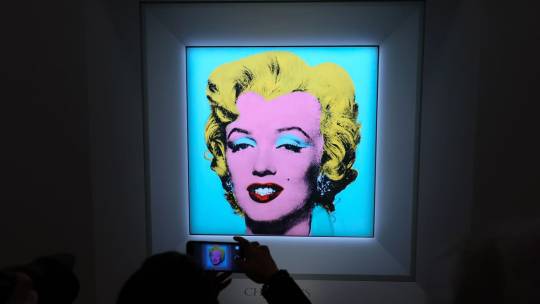


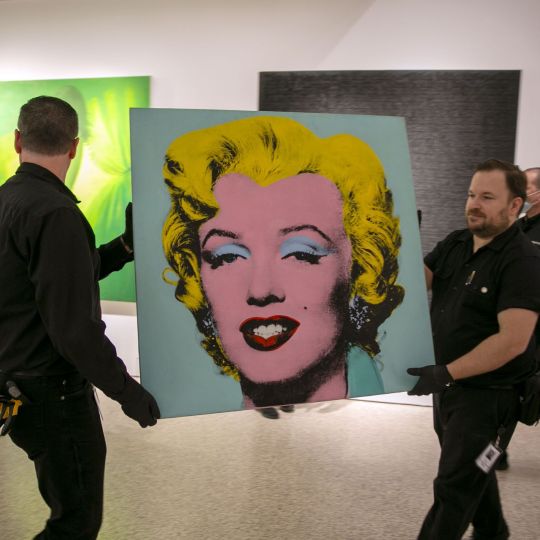
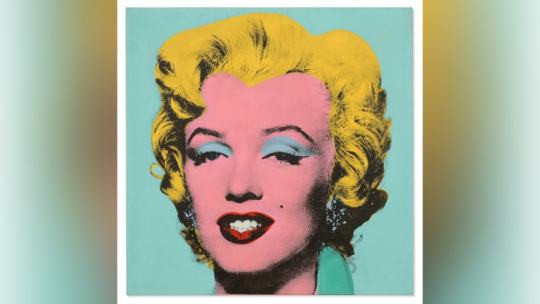

Andy Warhol's 1964 Portrait of Marilyn Monroe Sells a $195 Million
One of Andy Warhol's iconic Marilyn Monroe portraits has become the most expensive 20th-century artwork ever to go under the hammer.
The 40-square-inch "Shot Sage Blue Marilyn," one of dozens of images the artist made of Monroe in the 1960s, sold for a record $195 million at Christie's in New York Monday evening.
Prior to the sale, Christie's had described "Shot Sage Blue Marilyn" as "one of the rarest and most transcendent images in existence." It has previously been shown at galleries including the Guggenheim Museum in New York, the Centre Pompidou in Paris and London's Tate Modern.
The auction house had initially said it was expecting bids "in the region of" $200 million.
Warhol's colorful reproductions of Monroe's photo portrait -- originally a publicity still from her 1953 movie "Niagara" -- are among his most recognizable works, alongside his signature paintings of Campbell's soup cans.
Using a technique called silkscreen printing, which duplicates images on paper or canvas using a layer of fine-mesh silk like a stencil, he began creating them in 1962, shortly after Monroe's death. As with his depictions of other famous figures, including Elvis Presley and Chinese leader Mao Zedong, the Pop artist created numerous versions of Monroe's portrait in various different colors and configurations.
Among the best-known is "Marilyn Diptych," owned by British gallery group Tate, which saw Warhol print a grid of 50 portraits across two canvases. Elsewhere, the Museum of Modern Art's "Gold Marilyn Monroe" features a single image printed against a gold background, while "Shot Marilyns" saw the artist shooting portraits of the star through the head with bullets.
In 1964, he developed a "more refined and time-intensive" new process that was "antithetical to the mass production he was best known for," according to Christie's. That year, he used it to create a limited number of portraits -- a rare group of works to which "Shot Sage Blue Marilyn" belongs -- before abandoning the technique.
While a handful of paintings are thought to have attracted price tags in excess of $200 million in private sales (including works by the Abstract Expressionist painters Willem de Kooning and Jackson Pollock), the feat has only once been achieved at auction -- by Leonardo da Vinci's "Salvator Mundi," which in 2017 sold for over $450 million. The previous auction record for a 20th-century painting was the $179.4 million paid for Pablo Picasso's "Les Femmes d'Alger (Version O)" in 2015.
The auction record for a Warhol work was previously held by "Silver Car Crash (Double Disaster)," which depicts the mangled aftermath of a road collision and sold for more than $105 million almost a decade ago. Several of the artist's other Marilyn images have also attracted huge sum at auction in recent years, with 1962's "White Marilyn" selling for $41 million in New York in 2014.
"Shot Sage Blue Marilyn," meanwhile, was owned by a succession of high-profile gallerists and collectors before being purchased by the late Swiss art dealer Thomas Ammann. The portrait was offered for auction by the Thomas and Doris Ammann Foundation Zurich, the charitable organization set up in his (and his sister's) name, which will use the proceeds to fund health and education programs for children worldwide, according to a press release.
n a press statement prior to the sale, Christie's chairman of 20th and 21st century art, Alex Rotter, described the work as "the absolute pinnacle of American Pop" and "the most significant 20th century painting to come to auction in a generation."
"Standing alongside Botticelli's 'Birth of Venus,' Da Vinci's 'Mona Lisa' and Picasso's 'Les Demoiselles d'Avignon,' Warhol's 'Marilyn' is categorically one of the greatest paintings of all time," he added.
The artwork was one of four Warhols in the Ammanns' collection on sale at Monday evening's auction. One of his famous "Flowers" silkscreen paintings went for $15.8 million, and "GE/Skull," which he created in collaboration with the late Jean-Michel Basquiat, fetched over $4.6 million. Warhol's sculpture "Heinz Tomato Ketchup Box" meanwhile sold for more than $478,000.
Elsewhere, works by Robert Ryman, Alberto Giacometti and Lucian Freud also went under the hammer. Two of the biggest sellers were paintings by American artist Cy Twombly, "Untitled" and "Venere Sopra Gaeta," which fetched $21 million and almost $17 million respectively.
#Andy Warhol's 1964 Portrait of Marilyn Monroe Sells a $195 Million#Shot Sage Blue Marilyn#American artist film director and producer#art#artist#art work#art news#luxury#luxury goods#luxury living#luxury lifestyle#billionaire#billionaire lifestyle#Christie's#painting#auction#marilyn monroe
28 notes
·
View notes
Text
SAG-AFTRA, Teamsters, IATSE, Writers Guild Issue Joint Statement in Solidarity with Directors Guild of America
May 31, 2023
Los Angeles, CA — As the Directors Guild of America’s negotiations with the Alliance of Motion Picture and Television Producers (AMPTP) enter their final scheduled week, the International Alliance of Theatrical Stage Employees (IATSE), the Teamsters, Hollywood Basic Crafts (Teamsters Local 399, IBEW Local 40, LiUNA! Local 724, OPCMIA Local 755 and UA Local 78), the Writers Guild of America East (WGAE), the Writers Guild of America West (WGAW), and the Screen Actors Guild-American Federation of Television and Radio Artists (SAG-AFTRA) stand alongside our sisters, brothers, and kin in the DGA in their pursuit of a fair contract.
We believe in a Hollywood where every worker is valued and their contributions recognized, whether their labor is on or off screen. A fair contract for directors does not benefit just a select few; it uplifts every worker in the film and television industry and acknowledges the interconnected nature of our work. We call on the AMPTP to immediately negotiate a fair agreement that addresses the Directors Guild of America’s unique priorities in good faith.
As eyes around the world again turn towards the negotiation table, we send a clear message to the AMPTP: Our solidarity is not to be underestimated. The Hollywood guilds and unions stand united, and we stand strong.
In solidarity,
Matthew D. Loeb
International President, IATSE
Lindsay Dougherty
Motion Picture Division Director & Western Region Vice President, Teamsters
Hollywood Basic Crafts, Chairperson
Duncan Crabtree-Ireland
National Executive Director and Chief Negotiator, SAG-AFTRA
Michael Winship
President, Writers Guild of America, East
Meredith Stiehm
President, Writers Guild of America West
2K notes
·
View notes
Text
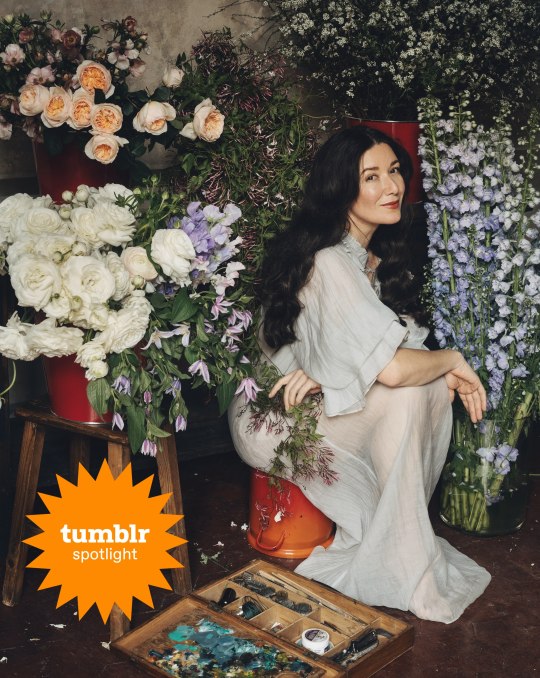
Writer Spotlight: Jamie Beck
Jamie Beck is a photographer residing in Provence, France. Her Tumblr blog, From Me To You, became immensely successful shortly after launching in 2009. Soon after, Jamie, along with her partner Kevin Burg, pioneered the use of Cinemagraphs in creative storytelling for brands. Since then, she has produced marketing and advertising campaigns for companies like Google, Samsung, Netflix, Disney, Microsoft, Nike, Volvo, and MTV, and was included in Adweek Magazine’s “Creative 100” among the industry’s top Visual Artists. In 2022, she released her first book, An American in Provence, which became a NYT Bestseller and Amazon #1 book in multiple categories, and featured in publications such as Vogue, goop, Who What Wear, and Forbes. Flowers of Provence is Jamie’s second book.
Can you tell us about how The Flowers of Provence came to be?
I refer to Provence often as ‘The Garden of Eden’ for her harmonious seasons that bring an ever-changing floral bounty through the landscape. My greatest joy in life is telling her story of flowers through photography so that we may all enjoy them, their beauty, their symbolism, and their contribution to the harmony of this land just a bit longer.

(Photograph: Jamie Beck)
How do your photography and writing work together? Do you write as part of your practice?
I constantly write small notations, which usually occur when I am alone in nature with the intention of creating a photograph or in my studio working alone on a still life. I write as I think in my head, so I have made it a very strict practice that when a thought or idea comes up, I stop and quickly write the text in the notes app on my phone or in a pocket journal I keep with me most of the time. If I don’t stop and write it down at that moment, I find it is gone forever. It is also the same practice for shooting flowers, especially in a place as seasonal as Provence. If I see something, I must capture it right away because it could be gone tomorrow.

(Photograph: Jamie Beck)
You got your start in commercial photography. What’s something you learned in those fields that has served you well in your current creative direction?
I think my understanding of bridging art and commerce came from my commercial photography background. I can make beautiful photographs of flowers all day long, but how to make a living off your art is a completely different skill that I am fortunate enough to have learned by working with so many different creative brands and products in the past.

(Photograph: Jamie Beck)
Do you remember your first photograph?
Absolutely! I was 13 years old. My mother gave me her old Pentax 35mm film camera to play with. When I looked through the viewfinder, it was as if the imaginary world in my head could finally come to life! I gave my best friend a makeover, put her in an evening gown in the backyard of my parents’ house in Texas, and made my first photograph, which I thought was so glamorous! So Vogue!
You situate your photographic work with an introduction that charts the seasons in Provence through flowers. Are there any authors from the fields of nature writing and writing place that inspire you?
I absolutely adore Monty Don! His writing, his shoes, and his ease with nature and flowers—that’s a world in which I want to live. I also love Floret Flowers, especially on social media, as a way to learn the science behind flowers and how to grow them.
How did you decide on the order of the images within The Flowers of Provence?
Something I didn’t anticipate with a book deal is that I would actually be the one doing the layouts! I assumed I would hand over a folder of images, and an art director would decide the order. At first, it was overwhelming to sort through it all because the work is so personal, and I’m so visual. But in the end, it had to be me. It had to be my story and flow to be truly authentic. I tried to move through the seasons and colors of the landscape in a harmonious way that felt a bit magical, just as discovering Provence has felt to me.

(Photograph: Jamie Beck)
How do you practice self-care when juggling work and life commitments alongside the creative process?
The creative process is typically a result that comes out of taking time for self-care. I get some of my best ideas for photographic projects or writing when I am in a bath or shower or go for a long (and restorative) walk in nature. Doing things for myself, such as how I dress or do my hair and makeup, is another form of creative expression that is satisfying.
What’s a place or motif you’d like to photograph that you haven’t had a chance to yet?
I am really interested in discovering more formal gardens in France. I like the idea of garden portraiture, trying to really capture the essence and spirit of places where man and nature intertwine.
Which artists do you return to for inspiration?
I’m absolutely obsessed with Édouard Manet—his color pallet and subject matter.
What are three things you can’t live without as an artist?
My camera, the French light, and flowers, of course.
What’s your favorite flower to photograph, and why?
I love roses. They remind me of my grandmother, who always grew roses and was my first teacher of nature. The perfume of roses and the vast variety of colors, names, and styles all make me totally crazy. I just love them. They simply bring me joy the same way seeing a rainbow in the sky does.

(Photograph: Jamie Beck)
#writer spotlight#jamie beck#the flowers of provence#art#photography#flowers#cottagecore#aesthetics#naturecore#flowercore#still life#nature aesthetic#artist#artists on tumblr#fine art photography#long post#travel#France#Provence#original photographers#photographers on tumblr
1K notes
·
View notes
Text

Today In History
Hollywood icon, director, activist, and diplomat Sidney Poitier was the first African American to win an Academy Award for Best Actor, receiving the honor in 1964 for his performance in ‘Lilies of the Field.’
Poitier was born in Miami, FL, on this date February 20, 1924-two and a half months prematurely while his parents were on vacation from the Bahamas.
Poitier portrayal of resolute heroes in films like “To Sir With Love,” “In the Heat of the Night” and “Guess Who’s Coming to Dinner” established him as Hollywood’s first Black matinee idol and helped open the door for Black actors in the film industry.
He rose to prominence when the civil rights movement was beginning to make headway in the United States. Although often simmering with repressed anger, his characters responded to injustice with quiet determination. They met hatred with reason and forgiveness, sending a reassuring message to white audiences.
With the rise of Black filmmakers like Gordon Parks and Melvin Van Peebles in the late 1960s and early ’70s, Mr. Poitier, now in his 40s, turned to directing and producing. He had proposed the idea for the romantic comedy “For Love of Ivy” (1968), in which he starred with Abbey Lincoln. After joining with Paul Newman and Barbra Streisand in 1969 to form a production company called First Artists, he directed the western “Buck and the Preacher�� (1972), in which he acted opposite Mr. Belafonte, and a series of comedies, notably “Uptown Saturday Night” (1974) and “Let’s Do It Again” (1975), in which Mr. Poitier and Bill Cosby teamed up to play a pair of scheming ne’er-do-wells, and “Stir Crazy” (1980), with Richard Pryor and Gene Wilder.
CARTER™ Magazine
#sidney poitier#carter magazine#carter#historyandhiphop365#wherehistoryandhiphopmeet#history#cartermagazine#today in history#staywoke#blackhistory#blackhistorymonth
107 notes
·
View notes
Text
'If Peaky Blinders made the Irish actor a household name, will Christopher Nolan’s nuclear blockbuster send him into the stratosphere? He talks about extreme weight loss, hating school and why his next character won’t be a smoker.
Cillian Murphy is struggling with what he can and can’t say about his title role in Oppenheimer, the latest Christopher Nolan epic, such is the secrecy surrounding this film. Murphy is under “strict instructions” not to talk about the content. Which is awkward when you’ve flown to his home in Ireland to interview him specifically about playing the physicist who oversaw the creation of the atomic bomb, later detonated over Hiroshima and Nagasaki. It’s not clear who issued these instructions. Nolan? The studio? The US government? All I know is that as well as Murphy being gagged by hefty NDAs, I am not allowed to see it (“bit unfortunate”, he concedes).
So, yes, here we sit in an empty upstairs room of a restaurant near his house in Monkstown, Dublin, working out how to do this. The room is dark, the sun shining through a solitary Velux lighting his features like a Géricault. The only background noise is the low hum of a wine refrigerator. Murphy loathes interviews, looks visibly tortured at points. But he relaxes when I ask if he’s pleased with Oppenheimer. “I am, yeah,” he says. “I don’t like watching myself – it’s like, ‘Oh, fucking hell’ – but it’s an extraordinary piece of work. Very provocative and powerful. It feels sometimes like a biopic, sometimes like a thriller, sometimes like a horror. It’s going to knock people out,” he adds. “What [Nolan] does with film, it fucks you up a little bit.”
Nolan wouldn’t disagree. The director recently told Wired magazine that some of those who’d seen it were left “absolutely devastated … they can’t speak”. Which sounds like a bad thing, but is related perhaps to the thought of the 214,000 Japanese people, overwhelmingly civilians, who lost their lives when the bombs were dropped. Kai Bird, the historian who co-authored American Prometheus, the 2008 biography of J Robert Oppenheimer upon which the film is based, said he was still “emotionally recovering” from seeing the film, clarifying that it was “a stunning artistic achievement”.
Murphy’s portrayal is said to be astonishing (“Oscar-worthy” is the buzz). This is not unbelievable. While Hollywood might not know him as a leading man, this quietly intense actor has long been celebrated in the UK and Ireland, most notably for his nine-year stint as Tommy Shelby in Peaky Blinders. When he first appeared on our screens, looking like a renaissance painting of Saint Sebastian – chiselled head contrasting with translucent blue eyes – it was impossible not to be distracted. He appeared first on stage in Enda Walsh’s Disco Pigs, then the screen adaptation. Then 28 Days Later; Intermission; Ken Loach’s The Wind That Shakes the Barley. Previous collaborations with Nolan include the Dark Knight trilogy, Inception and Dunkirk, “significant milestones in my career,” he says, adding that Nolan “might be the perfect director”.
It was Nolan’s wife, the producer Emma Thomas, who called Murphy one afternoon at the home he shares with his wife, artist Yvonne McGuinness, and two teenage sons. Nolan doesn’t actually have a telephone, or an email, or computer for that matter: “He’s the most analogue individual you could possibly encounter.” So, Emma said Chris would like a word and passed the receiver, then the director came on the line. “Cillian, I’d love you to play the lead in this new thing,” he said. Murphy tries to recreate his response to this news. “I was lost for words. But thrilled. Like beyond thrilled.” It is characteristic of Murphy that the modulation of his voice barely changes as he expresses this. He was so stunned, he had to sit down. “Your mind explodes.”
In the absence of the three-hour feature, I scrutinise Oppenheimer’s three-minute trailer. It’s a rush of snapshots against the crackling of a Geiger counter. There’s Murphy, short back and sides, lifting 1940s eye goggles; blue and red atoms coming at him fast; orange light; white light; blackout; silence. Massive explosion against the backdrop of space. Overlaid is Murphy’s narration, “We’re in a race against the Nazis / and I know what it means / if the Nazis have a bomb.” There’s Matt Damon looking porky as army general Leslie Groves, director of the Manhattan Project: “They have a 12-month head start.” Murphy, pointing with cigarette: “18.”
He has put back on some of the weight he lost for the part, I’m relieved to see; his skin isn’t quite so taut over his skull and there are freckles over those eagle-wing cheekbones. He was determined to nail the scientist’s silhouette “with the porkpie hat and the pipe”, testing himself to see how little he could eat. “You become competitive with yourself a little bit which is not healthy. I don’t advise it.” He won’t say how many kilograms he lost, or what food the nutritionist told him to cut out. NDA? “Ach, no. I don’t want it to be, ‘Cillian lost x weight for the part’.”
Then again, the hurtling speed at which Nolan worked, crisscrossing the US, made it easy to skip meals. Murphy began to forget about food in the same way he began to forget about sleep. “It’s like you’re on this fucking train that’s just bombing. It’s bang, bang, bang, bang. You sleep for a few hours, get up, bang it again. I was running on crazy energy; I went over a threshold to where I was not worrying about food or anything. I was so in it, a state of hyper …” he gropes for the word, “hyper something. But it was good because the character was like that. He never ate.” Oppenheimer subsisted on little more than Chesterfield cigarettes and double-strength martinis, rims dipped in lime. “Cigarettes and pipes. He would alternate between the two. That’s what did for him in the end,” Murphy adds, a nod to the scientist’s death from cancer in 1967. “I’ve smoked so many fake cigarettes for Peaky and this. My next character will not be a smoker. They can’t be good for you. Even herbal cigarettes have health warnings now.”
I raise method acting and Murphy tilts his head and frowns. “Method acting is a sort of … No,” he says, firm but with a half smile. Oppenheimer had many defining characteristics, not least walking on the balls of his feet and a vocal tic that sounded like nim-nim-nim, but Murphy didn’t want to do an impression. Nolan was obsessed with the Brillo-texture hair, so they spent “a long time working on hair”. And the voice. The real question for Murphy was what combination – ambition, madness, delusion, deep hatred of the Nazi regime? – allowed this theoretical physicist to agree to an experiment he knew could obliterate humankind. “He was dancing between the raindrops morally. He was complex, contradictory, polymathic; incredibly attractive intellectually and charismatic, but,” he decides, “ultimately unknowable.
“Listen, it’s not like a spoiler,” he says, checking himself before he leans in, “but there are incidents in his early life that were quite worrying; very erratic.” They are in the film and the book, he steers. I suspect he is referring to Oppenheimer’s postgrad at Cambridge in 1926, when he placed a poisoned apple on the desk of a tutor towards whom he harboured complicated feelings of inadequacy and jealousy. Arguably, this was attempted murder. But Oppenheimer’s rich New York parents rushed in to bundle him into psychoanalysis. He was diagnosed with “dementia praecox”, a term describing symptoms associated with schizophrenia.
Murphy likes these complex characters; they’re his meat. People that don’t necessarily follow the – yawn – traditional transformative arc of storytelling. Not villains, exactly (although he’s played a few, including Scarecrow in Dark Knight and Jackson Rippner in Red Eye): “Villains are good if they’re well written, but if it’s one note or a trope, then they are dull.” He likes a script to stretch leisurely into all corners of the human condition, “all the shades”. At the same time, you have to understand his exceptional ability to portray interiority, physically manifesting intense human emotion without a word, radiating fierce, consuming energy. Which he does today, actually, when I stray off track.
Although Nolan is usually, shall we say, antiseptic in his approach to romance, Oppenheimer represents a significant shift. He told Wired the love story aspect “is as strong as I’ve ever done”. It features prolonged full nudity for Murphy and Florence Pugh, who plays Oppenheimer’s ex-fiancee, as well as sex, and there are complicated scenes with Emily Blunt, who plays his wife, “that were pretty heavy”. Murphy turns coy: “I’m under strict instructions not to give away anything.”
He asks if I’ve heard of chemistry tests. “They put two actors in a room to see if there’s any spark, and have all the producers and director at a table watching. I don’t know what metric they use, and it seems so outrageously silly, but sometimes you get a chemistry and nobody knows why.” This is a roundabout way of saying his scenes with Blunt and Pugh conjure this magic. His established bond with Blunt (they co-starred in A Quiet Place II) meant “the audience gets something for free”, he says. “You can be immediately vulnerable and open, and try stuff. There were moments where I remember saying, ‘I couldn’t have done that if it wasn’t with you.’”
Murphy, 47, grew up the eldest of four in Cork. His father was a civil servant, his mother a French teacher. They were a middle-class family, musical; his father “can pick up any instrument”, his brother played piano, and they regularly got stuck into “traditional Irish sessions”. Bookshelves were stuffed with literature, the radio often on, the “shitty” TV set not so much. Home life was busy but his parents taught him French and Irish, and sent him to an all-boys academic, rugby-playing private school. “I got all the education” he says, drily.
The story of how much he disliked the Presentation Brothers College, the hard-drinking masculine emphasis, how he found solace playing guitar in a band, is much rehearsed and he says today he doesn’t want “to slag the school off. I hear it’s great now.” Something about this experience seems nonetheless unsettling. He had one friend, who is still his best friend, “so I wasn’t, like, an outcast”. He played rugby for the first couple of years, but abandoned it “because everyone was all of a sudden towering over me.” Was it an unhappy time? He shifts. “It was OK. I was a bit of a messer, like I’d get in trouble and say nothing. It wasn’t the ideal school for me.”
He enrolled in and dropped out of a law degree at University College Cork, which created some friction with his parents (when I ask if his own sons will go to university in Dublin, he says, “Whatever they want”). He continued with the band, his first creative love but the one that got away. When they were offered a contract with Acid Jazz records, he turned it down for a number of reasons, he says, crucially that he didn’t feel good enough. He still writes and plays at home but, no, you won’t be hearing any of his recordings, ever, he says.
It’s a funny thing talking to Murphy. He’s at once garrulous (on the craft, or literature, or ideas) and reticent (pretty much anything else). I sense in previous interviews that he skates over issues close to his heart – such as the expression of emotion in Ireland and the need to teach empathy in schools. But when I try to drill in to these topics, get to the root, he clams shut, emitting energy like a nuclear reactor.
Later, in a different context, he will tell me a truth: “I’m stubborn and lacking in confidence, which is a terrible combination. I don’t want to put anything out that I don’t think is excellent.” But he clearly hates the pantomime of publicity, asking why I am returning to certain topics and repeating lines I’ve read elsewhere. I can almost see him at home with its views towards the Irish Sea, complaining to his wife as they tuck into supper: “Another one, asking the same fucking questions.”
If he could get out of going to Cannes, of standing on red carpets, dressed as is his habit for a funeral, hair shellacked, hands in pockets; if he could turn his back on the coloured-foam mics thrust in his face, he would. He really would. No, it dawns on him now, there’s something even worse than the red carpet; there’s the talkshow rounds. The very word “talkshow” comes out of him like a pain from his ribcage, as if the parcelling out of amuse-bouche anecdotes, offering them up to the forced laughter of that false god of show business, the studio audience, is in itself the most cheapening experience known to mankind.
“I do them because you’re contractually obliged to. I just endure them. I’ve always found it difficult. I’ve said this so many, many times.” Then there’s the double wince of realising that, yes, he’s done it again. He’s laid into the industry that feeds him. His hands raise slowly in surrender. “I want to just caveat this by saying, I’m so privileged. I’m so happy to be doing what I love. I’m really lucky. But I don’t enjoy the personality side of being an actor. I don’t understand why I should be entertaining and scintillating on a talkshow. I don’t know why all of a sudden that’s expected of me. Why?”
There’s an awkward silence. I say that he reminds me of Naomi Osaka, the tennis player who refused to talk to journalists after the French Open in 2021. He says he feels “100%” sympathy with her, “because why should she have to perform?” Then he relents. “But I get it. I get it’s a kind of ecosystem where the film feeds the publicity which feeds the talkshows which goes back and feeds the film, so, like, that’s how it works. I suppose I’m just not good at it. At interviews, at this stuff,” he gestures at me. He says after he leaves me today he’ll be going down the stairs thinking of all the things he’s said and worrying it’s come across all wrong. “Do you know what Sam Beckett said? ‘I have no views to inter.’ I love that. That should be the interview.”
We return to his art, the tension falls away and he’s back to his charming self, charged air evaporating. Since Oppenheimer, he’s also wrapped Small Things Like These, an adaptation of Claire Keegan’s brilliant novella set in 1985 in a small Irish town on the edge of which is a convent and “laundry”. Murphy is a huge fan of Keegan. He remembers reading her 2010 novel Foster on a train and having to pull his hoodie over his face because he was crying so hard. Anyway, he’d wanted to work with the Peaky Blinders director Tim Mielants and they were throwing ideas around in his sitting room when Murphy’s wife suggested Small Things. “No, there’s no way,” Murphy said. “That’s going to be gone already.” But when he called the agent, he found it was available. “I went, ‘No, you’ve got to be fucking kidding.’” Murphy pitched the idea to Matt Damon, who has set up a studio with Ben Affleck. “From there it all just happened really quickly.”
Murphy plays Bill Furlong who, funnily enough, is a man of few words. Keegan’s light-touch writing is everything he loves in art – the sense that you are not being bashed over the head by an idea. That’s how he tries to act, he adds. “I’m always trying to cut lines in scenes, because I feel like you can transmit it. Like when you see a person on a train thinking, or driving a car, and you are purely observing someone and feeling the energy that is vibrating from them. That’s the sort of acting I love. In a lot of film and television, they want to cut those bits to go to the action. I like films that pose the big questions and then leave it to the audience.” Perhaps this is at the heart of his reticence in interviews? That he doesn’t feel the need to explain.
He still finds it “nuts” that the last of the Magdalene laundries closed in 1996, that it was illegal to buy condoms in Ireland until 1985, that divorce was made legal only in 1996. He remembers vividly thousands of people still going to see moving statues in Cork when he was growing up. “Crazy. But, like, how far the country has come since then, we’re so socially advanced now compared with where we were. But you must look back. And art is a better way of doing that than reading all these reports [into the laundries].” (Afterwards, he emails me: “The nation is actually dealing with an unresolved collective trauma. Who knows how long this will take to heal, but I feel strongly that art, film and literature can help with that process. It’s a kinder and gentler sort of therapy. I hope that our movie can help with that in its own little way.”)
Because he’s a nice man, because he doesn’t want me to feel bad about our encounter, and because he’s generous and hospitable, Murphy finishes by telling me some of the best places to visit in Ireland. He and his family are staying here for the summer. They’ve had it with air travel and his home town of Cork is only a couple of hours away. He supplies me with other recommendations: a great book he’s just read, Brian, by Jeremy Cooper, oh, and there’s the Francis Bacon studio exhibition I should catch on my way out.
But before I go, what has he learned from playing Oppenheimer? Foremost, he says, that scientists think differently. He knew this already from playing physicist Robert Capa in Danny Boyle’s Sunshine (2007) and hanging out in Cern, home of the Large Hadron Collider in Geneva, for research. “I had dinner with all these geniuses. I’ll never understand quantum mechanics, but I was interested in what science does to their perspective.” He sought their opinions on subjects that matter – love, politics, our place in the universe, “infinity, or whatever the fuck. Because they have a completely different way of taking in information than we do. I remember one scientist saying, ‘I don’t believe in love. It’s a biological phenomenon, the exchange of hormones between the female and the male. That’s all. Love is a nonsense.’” Murphy taps the table with his hand. “I couldn’t go along with that, obviously.”
#Cillian Murphy#Oppenheimer#Christopher Nolan#Emily Blunt#Florence Pugh#Danny Boyle#Sunshine#Brian by Jeremy Cooper#Small Things Like These#Claire Keegan#A Quiet Place II#Peaky Blinders#Tommy Shelby#Disco Pigs#28 Days Later#Intermission#The Wind That Shakes The Barley#The Dark Knight Trilogy#Inception#Dunkirk#Scarecrow#Jackson Rippner#Red Eye#Bill Furlong
166 notes
·
View notes
Text
Kaiju Week in Review (March 10-16, 2024)
"It looks as though its Japanese producers, assisted by a stray American—fellow named Terry Morse, who is an alumnus of Hollywood's Poverty Row—made a close study of the old film, "King Kong," then tried to do substantially the same thing with a miniature of a dinosaur made of gum-shoes and about $20 worth of toy buildings and electric trains." —Bosley Crowther, reviewing Godzilla, King of the Monsters! for The New York Times
"The special effects are hardly special, but hey, what do you expect in a Japanese monster movie?" —Tony Kiss, reviewing Godzilla 1985 for the Asheville Citizen-Times
"Sure it's bad filmmaking. Sure it's a guy—actor Tsutomu Kitagawa—clad in a nearly vintage latex Godzilla getup and stomping through Tokyo, knocking down cardboard mini-buildings and upending toy-sized cars with his gnarly feet. But that's the point." —Bob Longino, reviewing Godzilla 2000 for The Palm Beach Post

Godzilla Minus One won the Oscar for Best Visual Effects at the 96th Academy Awards, sending a stunned Takashi Yamazaki (VFX supervisor), Kiyoko Shibuya (VFX director), Masaki Takahashi (3D CG director), and Tatsuji Nojima (VFX artist/compositor) to the Dolby Theatre stage. Said Yamazaki, reading from prepared comments in English, "To someone so far from Hollywood, the possibility of standing on this stage seemed out of reach." I could scarcely believe what I was watching myself, despite having given a presentation for a Wikizilla stream mere hours before on Minus One's very real chances of beating more expensive American contenders. Everything I said about its nomination goes triple for its victory; we'll be talking about this one forever. To those of us who remember when Godzilla was basically a joke in the American consciousness (including my Wikizilla colleague Darthlord1997, who had a speech of his own prepared), it's the ultimate vindication.
youtube
Never one to rest on his laurels, Takashi Yamazaki directed an ad for Ajinomoto about food waste which released this week. It features the unsubtly-named Foodlosslla attacking Tokyo and facing an Ultraman-esque defense team. As with Minus One, the ad's visuals are a clever combination of high-end (a detailed CG monster) and low-end (dropping plastic fruit on top of fleeing extras).
youtube
Last year, the 4Kids Flashback podcast interviewed Mike Pecoriello, producer and writer for the company's renditions of Yu-Gi-Oh! and Ultraman Tiga, and he delivered some major news about the latter. Although only 23 episodes of Tiga aired in the U.S., 4Kids dubbed the whole thing. At the time of the podcast's recording, he thought he made copies of all the episodes, but while that doesn't seem to be the case, he did provide 4Kids Flashback with the series finale. It's a good deal more serious than the episodes which aired, with the quips kept to a minimum. Let the hunt for the rest commence!

SciFi Japan has details on Kaiju Yarrow, a Japanese comedy doubling as a tourism ad for the city of Seki. The premise is very self-aware:
KAIJU YARROW! is set in Seki City, Gifu Prefecture. One day, 30 year old Ichiro Yamada, who works in the tourism department of a government office, is ordered by the mayor to produce a "local film.''
However, Yamada, didn't want to produce the typical "mediocre local movies'' that are everywhere nowadays, so he comes up with the idea of making a "monster movie'', which has been his life-long dream. However, his dreams develops into a major incident involving the city government...!
Will Yamada be able to complete his life goal of making a monster movie??
Junichiro Yagi will direct; YouTuber Gunpee will star. Unknown quantities both when it comes to kaiju, so how this will turn out is anyone's guess.
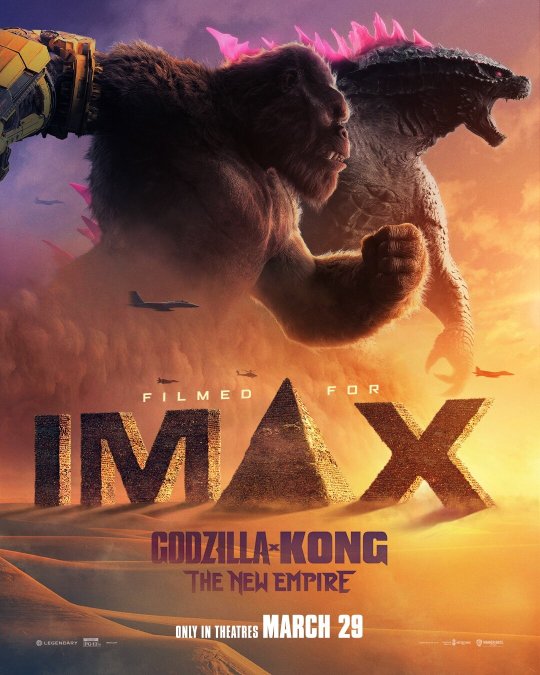
Tickets for Godzilla x Kong: The New Empire have gone on sale in the U.S.—and as a reminder, the brief GKIDS theatrical release of The End of Evangelion wraps tomorrow.
#godzilla minus one#oscars#ultraman tiga#kaiju yarrow#takashi yamazaki#godzilla x kong the new empire#kaiju week in review#godzilla#kaiju
29 notes
·
View notes
Text
Dylan O’Brien Was in the Audience of ‘Watch What Happens Live With Andy Cohen’ — and Us Has Questions
By Yana Grebenyuk October 18, 2023

Dylan O’Brien has all of Us wondering what his favorite Bravo shows are after his surprise audience appearance on Watch What Happens Live With Andy Cohen.
Host Andy Cohen kicked off the show on Tuesday, October 17, by introducing guests Real Housewives of Salt Lake City star Monica Garcia and comedian Heather McMahan. He then pointed out that O’Brien, 32, and producer Tommy Alter were both in the audience. Cameras switched to O’Brien who did a thumbs up for viewers while sipping a drink.
“I want to welcome our friends Dylan O’Brien and Tommy Alter to the Clubhouse. Great to see you! Dylan being a huge Vanderpump Rules fan, I found out tonight. I love it,” Cohen, 55, said as the audience cheered.
O’Brien was not mentioned again, but he did get fans talking about the unexpected cameo. “This feels random. Dylan O’Brien is in the #WWHL audience tonight!” a social media commentator wrote via X.
Meanwhile, another viewer poked fun at O’Brien enjoying himself in New York City, writing, “Just dylan o’brien in his natural state (sipping on his drink) in the audience of wwhl tonight.”
O’Brien was photographed hours prior showing his support for the ongoing SAG-AFTRA strike on the picket line. He wore a hoodie that referenced the actors’ union, which he paired with green sweatpants and a red baseball hat.
The actor rose to stardom after playing fan-favorite character Stiles Stilinski on MTV’s hit series Teen Wolf from 2011 to 2017. O’Brien went on to score the role of Thomas in the Maze Runner film franchise. He has since also appeared in movies including Deepwater Horizon, American Assassin, Bumblebee, Love and Monsters and Not Okay.
O’Brien’s collaborations with Taylor Swift, however, have been our favorite part of his filmography so far. In 2021, O’Brien starred opposite Sadie Sink in Swift’s short film All Too Well. He was also credited as a drummer on Swift’s song “Snow on the Beach,” which was featured on her 2022 album Midnights.
After All Too Well scored five nominations at the MTV Video Music Awards, O’Brien praised Swift, 33, as an artist.
“She sent us the news first thing in the morning,” he told Entertainment Tonight in July 2022. “She’s genuinely just someone who’s so involved and just proud of her work and is so grateful for any accomplishment or recognition for something that she just poured herself into. Talk about a special human.”
According to O’Brien, he has been in a “group chat” with Swift and Sink, 21, since working on the music video together. “[Taylor] would make a really, really good director. If it’s something that her heart’s in, Taylor can do whatever she wants,” he added. “She could easily direct a feature and it’d be something I’d sign up for, for sure.”
Source: usmagazine.com
60 notes
·
View notes
Text
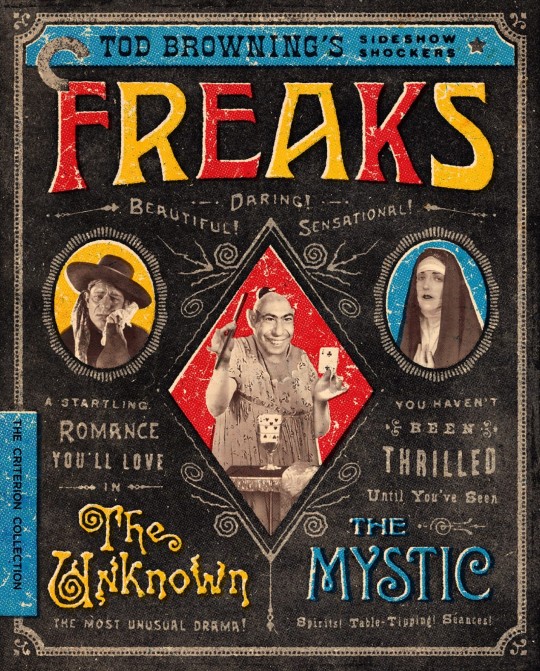
Tod Browning's Sideshow Shockers will be released on Blu-ray and DVD on October 17 via The Criterion Collection. The set collects three films directed by Tod Browning: Freaks, The Unknown, and The Mystic.
Freaks (also known as The Monster Story, Forbidden Love, and Nature's Mistake) is a 1932 horror film written by Willis Goldbeck and Leon Gordon. Wallace Ford, Leila Hyams, Olga Baclanova, and Roscoe Ates star.
The Unknown is a 1927 silent horror film written by Waldemar Young. Lon Chaney, Norman Kerry, Joan Crawford, and Nick De Ruiz star.
The Mystic is a 1925 silent drama film written by Browning and Young. Aileen Pringle, Conway Tearle, and Mitchell Lewis star.
Freaks has been digitally restored in 2K with uncompressed monaural sound. The Unknown has been digitally reconstructed and restored in 2K with a new score by composer Philip Carli. The Mystic has been digitally restored in 2K with a new score by composer Dean Hurley.
Raphael Geroni designed the cover art. Special features are detailed below.
Special features:
Freaks audio commentary by film scholar David J. Skal
The Unknown audio commentary by film scholar David J. Skal
The Mystic introduction by film scholar David J. Skal
Interview with author Megan Abbott about director Tod Browning and pre-Code horror (new)
Freaks archival documentary
"Spurs" - Reading of Tod Robbins' short story on which Freaks is based
Freaks prolgue, added to the film in 1947
Freaks alternate endings featurette
Freaks portrait video glalery
Essay by film critic Farran Smith Nehme

The most transgressive film produced by a major American studio in the 1930s, Tod Browning’s crowning achievement has haunted the margins of cinema for nearly one hundred years. An unforgettable cast of real-life sideshow performers portray the entertainers in a traveling circus who, shunned by mainstream society, live according to their own code—one of radical acceptance for the fellow oppressed and, as the show’s beautiful but cruel trapeze artist learns, of terrifying retribution for those who cross them. Received with revulsion by viewers upon its initial release, Freaks effectively ended Browning’s career but can now be seen for what it is: an audacious cry for understanding and a singular experience of nightmarish, almost avant-garde power.

The most celebrated and exquisitely perverse of the many collaborations between Tod Browning and his legendary leading man Lon Chaney, The Unknown features a wrenchingly physical performance from “the Man of a Thousand Faces” as the armless Spanish knife thrower Alonzo (he flings daggers with his feet) whose dastardly infatuation with his beautiful assistant (Joan Crawford)—a woman, it just so happens, who cannot bear to be touched by the hands of any man—drives him to unspeakable extremes. Sadomasochistic obsession, deception, murder, disfigurement, and a spectacular Grand Guignol climax—Browning wrings every last frisson from the lurid premise.

A fantastically atmospheric but rarely seen missing link in the development of Tod Browning’s artistry, set amid his favored milieu of shadowy sideshows and clever criminals, The Mystic provides a striking showcase for silent-era diva Aileen Pringle, who sports a series of memorably outré looks (courtesy of art-deco designer Erté) as Zara, a phony psychic in a Hungarian carnival who, under the guidance of a Svengali-like con man (Conway Tearle), crashes—and proceeds to swindle—American high society. Browning’s fascination with the weird is on full display in the eerie séance sequences, while his subversive moral ambiguity extends surprising sympathy to even the most seemingly irredeemable of antiheroes.
#tod browning#freaks#the unknown#the mystic#criterion#the criterion collection#criterion collection#dvd#gift#raphael geroni#horror#classic horror#lon chaney#joan crawford#silent horror
113 notes
·
View notes
Text
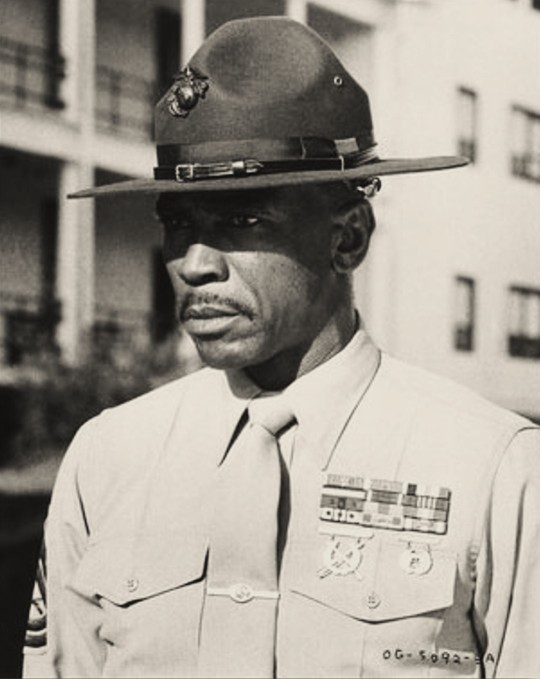
The actor Lou Gossett Jr, who has died aged 87, is best known for his performance in An Officer and A Gentleman (1982) as Gunnery Sergeant Emil Foley, whose tough training transforms recruit Richard Gere into the man of the film’s title. He was the first black winner of an Academy Award for best supporting actor, and only the third black actor (after Hattie McDaniel and Sidney Poitier) to take home any Oscar.
The director, Taylor Hackford, said he cast Gossett in a role written for a white actor, following a familiar Hollywood trope played by John Wayne, Burt Lancaster, Victor McLaglen or R Lee Ermey, because while researching he realised the tension of “black enlisted men having make-or-break control over whether white college graduates would become officers”. Gossett had already won an Emmy award playing a different sort of mentor, the slave Fiddler who teaches Kunta Kinte the ropes in Roots (1977), but he was still a relatively unknown 46-year-old when he got his breakthrough role, despite a long history of success on stage and in music as well as on screen.
Born in Sheepshead Bay, Brooklyn, Louis was the son of Helen (nee Wray), a nurse, and Louis Sr, a porter. As a child he suffered from polio, but became a high school athlete before a basketball injury led to his joining the drama club. His teacher encouraged him to audition professionally, and at 17 he was on Broadway playing a troubled child in Take a Giant Step, which won him a Donaldson award for best newcomer.
He won a drama scholarship to New York University, but continued working, in The Desk Set (1955), and made his television debut in two episodes of the NBC anthology show The Big Story. In 1959 he was cast with Poitier and Ruby Dee in Raisin in the Sun, and made his film debut reprising his role in 1961. On Broadway that year he played in Jean Genet’s The Blacks, in an all-star cast with James Earl Jones, Cicely Tyson, Roscoe Lee Brown, Godfrey Cambridge and a young Maya Angelou; it was the decade’s longest-running show.
Gossett was also active in the Greenwich Village folk music scene. He released his first single Hooka Dooka, Green Green in 1964, followed by See See Rider, and co-wrote the anti-war hit Handsome Johnny with Richie Havens. In 1967 he released another single, a drums and horns version of Pete Seeger’s anti-war hymn Where Have All the Flowers Gone. He was in the gospel musical Tambourines to Glory (1963) and in producer Mike Todd’s America, Be Seated at the 1964 New York World’s Fair.
His plays became more limited: The Zulu and the Zayda and My Sweet Charlie; the very short run of Carry Me Back to Morningside Heights, in which he played a black man owning a white slave; and a revival of Golden Boy (1964), with Sammy Davis Jr. His final Broadway part was as the murdered Congolese leader Patrice Lamumba, in Conor Cruise O’Brien’s Murderous Angels (1971). Gossett had played roles in New York-set TV series such as The Naked City, but he began to make a mark in Hollywood, despite LAPD officers having handcuffed him to a tree, on “suspicion”, in 1966.
On TV he starred in The Young Rebels (1970-71) set in the American revolution. In film, he was good as a desperate tenant in Hal Ashby’s Landlord (1970) and brilliant with James Garner in Skin Game (1971), taking part in a con trick in which Garner sells him repeatedly into slavery then helps him to escape.
In 1977, alongside Roots, he attracted attention as a memorable villain in Peter Yates’s hit The Deep, and got artistic revenge on the LAPD in Robert Aldrich’s The Choirboys. The TV movie of The Lazarus Syndrome (1979) became a series in which Gossett played a realistic hospital chief of staff set against an idealistic younger doctor. He played the black baseball star Satchel Paige in the TV movie Don’t Look Back (1981); years later he had a small part as another Negro League star, Cool Papa Bell, in The Perfect Game (2009).
After his Oscar, he played another assassinated African leader, in the TV mini-series Sadat, reportedly approved for the role by Anwar Sadat’s widow Jihan. Though he remained a busy working actor, good starring roles in major productions eluded him, as producers fell back on his drill sergeant image. He was Colonel “Chappy” Sinclair in Iron Eagle (1986) and its three dismal sequels.
But in 1989 he starred in Dick Wolf’s TV series Gideon Oliver, as an anthropology professor solving crimes in New York. And he won a best supporting actor Golden Globe for his role in the TV movie The Josephine Baker Story (1991). He revisited the stage in the film adaptation of Sam Shepard’s Curse of the Starving Class (1994).
Gossett twice received the NAACP’s Image Award, and another Emmy for producing a children’s special, In His Father’s Shoes (1997). In 2006 he founded the Eracism Foundation, providing programmes to foster “cultural diversity, historical enrichment and anti-violence initiatives”. Despite an illness eventually linked to toxic mould in his Santa Monica home, he kept working with a recurring part in Stargate SG-1 (2005-06). A diagnosis of prostate cancer in 2010 hardly slowed him down.
Most recently, he played Will “Hooded Justice” Reeves in the TV series Watchmen (2019), in the series Kingdom Business, about the gospel music industry, and in the 2023 musical remake of The Color Purple.
His first marriage, to Hattie Glascoe, in 1967, was annulled after five months; his second, to Christina Mangosing, lasted for two years from 1973; and his third, to Cyndi (Cynthia) James, from 1987 to 1992. He is survived by two sons, Satie, from his second marriage, and Sharron, from his third.
🔔 Louis Cameron Gossett Jr, actor, born 27 May 1936; died 28 March 2024
Daily inspiration. Discover more photos at Just for Books…?
19 notes
·
View notes
Text
THIS DAY IN GAY HISTORY
based on: The White Crane Institute's 'Gay Wisdom', Gay Birthdays, Gay For Today, Famous GLBT, glbt-Gay Encylopedia, Today in Gay History, Wikipedia, and more … February 16


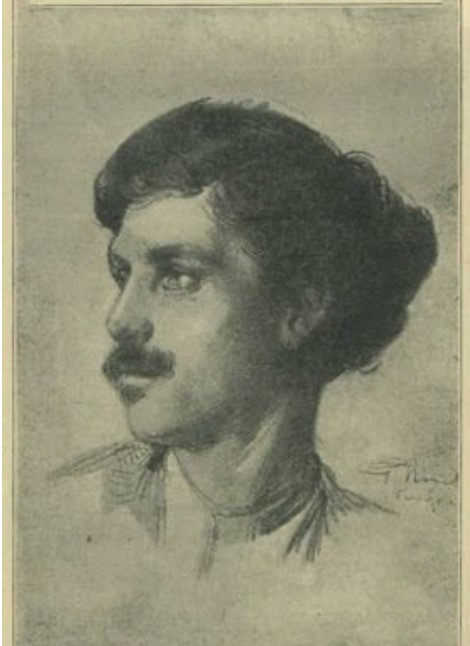
1854 – The Scottish writer and historian best known for his two volume Studies in the History of Venice, Horatio Forbes Brown, was born (d.1926). Alas, poor Brown. When the English writer died in 1926, his executors burned almost all his unpublished works, attempting to hide what his acquaintances already knew - that he was homosexual. Like the tastes of so many of his upper-class colleagues, and his close friend John Addington Symonds, Brown's ran to sailors, footmen, tram conductors, and other strapping members of the lower orders.
In 1879, Brown and his mother decided to live in Italy. They went first to Florence and then settled at Venice, taking an apartment in the Palazzo Balbi Valier on the Grand Canal. Symonds joined his friend Brown for holidays in Venice, when they liked to drift through the lagoons in Brown's sandolo (a smaller version of the gondola), called Fisole, which had orange sails decorated with a fleur-de-lis.

Venice in the 1800s
In 1885, the Browns bought a tall, narrow, tenement building on the Zattere looking down the Giudecca Canal and reconstructed it as a house called Cà Torresella. Brown's close friend Antonio Salin, his gondolier, also lived in the house with his wife and family.
In 1889, Brown took a job working for the British government's Public Record Office on Venetian state papers. From 1889 to 1905 he spent his mornings producing calendars covering the years from 1581 to 1613. In the afternoons he would go out and about with his gondolier, Salin. Brown's name as an historian was made by the five volumes of Calendar of State Papers (Venetian) which he published between 1895 and 1905.
The receptions he gave at home on Mondays were described by Frederick Rolfe, known as Baron Corvo.
Brown's friend Symonds appointed him his literary executor, so that in 1893 when Symonds died Brown received all his private papers. He went on to publish John Addington Symonds, a Biography (1895), followed in 1923 by Letters and Papers of John Addington Symonds. In both, he suppressed almost all of Symonds's homosexuality, and in Brown's own Will he left orders for the destruction of the papers, apart from Symonds's autobiography, and that was not to be published for at least fifty years.
Brown published some homoerotic poems in his collection Drift (1900), but was hostile to the Uranian writers in the circle of Edward Carpenter, and because of his suppression of the truth about Symonds they saw him as a hindrance to homosexual emancipation. One of his surviving poems, a psychological gem, depicts a boring society musicale in which Brown can't keep his eyes off a broad-shouldered servant when he should be concentrating on the performing artiste. Each stanza ends with the line, "But I liked their footman John the best." And he did, too.

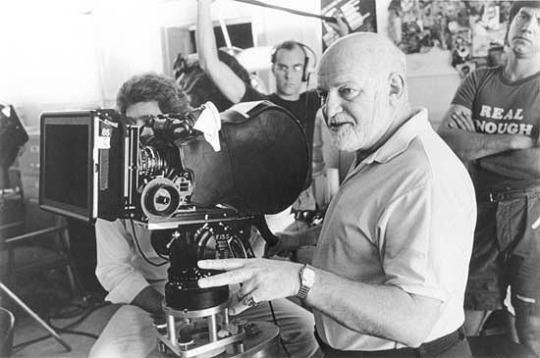
1926 – John Schlesinger, the English film director, was born on this date (d.2003). He was an unheralded pioneer. Always a daring innovator, Schlesinger was a significant force in introducing homosexual themes into mainstream British and American films.
His early work for the BBC led to his first feature film, Terminus (1961), a documentary set in a London train station. Subsequently, he was selected by producer Joseph Janni to direct a series of films that focused on the restlessness of young people coming of age at the beginning of the "swinging sixties."
Notable for their empathetic treatment of their youthful protagonists, these films featured such rising stars as Alan Bates, Tom Courtenay, and Julie Christie, and include A Kind of Loving (1962), Billy Liar (1963), and Darling (1965).

Schlesinger's first American film, Midnight Cowboy (1969), which won the Academy Award for Best Picture despite an "X" rating, focuses on a relationship between two men, a male hustler (Jon Voigt) and an ailing con artist (Dustin Hoffman). It also features a disturbing scene in which the hustler beats up a client. Midnight Cowboy was kicked to pieces by the critics for being too Gay, and by militant Gays for not being Gay enough.

Released in 1971, only four years after homosexual acts between male adults in private were decriminalized in Britain, Sunday Bloody Sunday explores a romantic triangle with a different twist: an older gay man (Peter Finch) and a divorcee (Glenda Jackson) become rivals for the sexual attention of a younger man (Murray Head).
A later film, The Next Best Thing (1999), takes a wry look at a one-night stand (and an ensuing pregnancy) between a gay man (Rupert Everett) and a straight woman (Madonna).
Schlesinger never made a secret of his homosexuality, and he lived quite openly with his partner Michael Childers from the late 1960s until the end of his life in 2003.
He became publicly "out," however, when, in 1991, Sir Ian McKellen, the first openly gay individual to be knighted by the British monarchy, was attacked in a public letter from filmmaker Derek Jarman for accepting the honor. Schlesinger was one of the dozen British gay and lesbian artists who signed a respectful response in McKellen's defense.
Schlesinger died on July 25, 2003 in Palm Springs, California, following a prolonged illness.

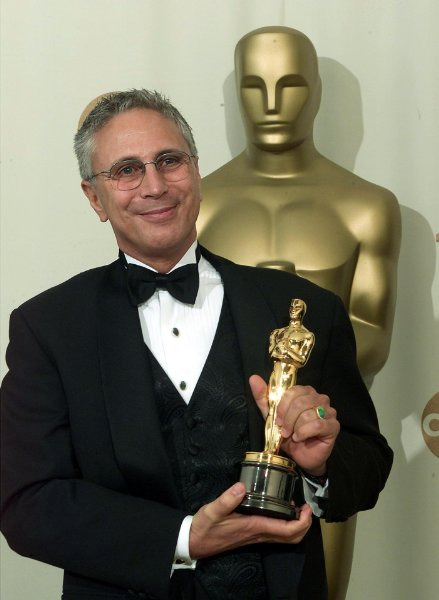
1938 – American composer of symphonies, chamber works, choral settings, operas, and film scores, John Corigliano has created some of the most moving music inspired by the AIDS epidemic.
Corigliano was born in New York into a highly musical family. His father was a distinguished violinist who was concertmaster of the New York Philharmonic from 1943 to 1966, while his mother was an accomplished pianist.
He is perhaps best known for his score to the film The Red Violin (1997), for which he received an Academy Award; his music for the opera The Ghosts of Versailles (1991), which was commissioned and premiered by the Metropolitan Opera, New York; and for his Symphony No. 1 (1990).
Symphony No. 1 was inspired by the loss of many of Corigliano's friends to AIDS. Commissioned by Sir Georg Solti and the Chicago Symphony Orchestra, the symphony is notable for its large scale and dark mood. Although inspired by the devastation of AIDS, the symphony also stands on its own as a piece of music devoid of specific historical context.
Its third movement, "Guilio's Song," includes a cello solo based on a theme improvised by Corigliano and his cellist friend Guilio Sorrentino. This third movement inspired the separate, briefer chaconne Of Rage and Remembrance (1993), which was commissioned by gay men's choruses in Seattle, New York City, and San Francisco.
Scored for chorus and soloists (mezzo-soprano, boy soprano, two tenors, and two baritones), this work is set to poetry about loss by poet and playwright William Hoffmann and farewells to various friends lost to AIDS; the work concludes with a verse from Psalm 23, "Yea, though I walk through the valley of the shadow of death," sung in Hebrew by a boy soprano.
The vocal score explicitly names friends of Corigliano and Hoffmann who have died of AIDS, and directs the singers to name friends whom they have lost to AIDS as well. Thus the work is not only an occasional piece but also a work in the long, venerable tradition of communal choral lament.
John Corigliano, who is openly gay, lives with his partner, composer Mark Adamo in New York City; the two were legally married in California by the conductor Marin Alsop in August 2008.


1957 – Max Wolf Valerio, born in Heidelberg, West Germany, is a poet, memoir writer, essayist and actor. He has lived for many years in San Francisco, California. He is of Kainai (Blackfoot/Blood), Sephardic Jewish Converso, and Northern European descent.
Valerio's 2006 memoir The Testosterone Files is one of his most prominent pieces of writing. It describes his transformation and experiences as a trans man. He also writes and performs poetry, and acts on both film and stage.
Max was born in a United States Army hospital in Heidelberg Germany and then, traveled to San Francisco after a year and a half. They lived on the Presidio Army base while there before traveling on after another 18 months. Valerio lived in many states including Maryland, Washington, California, Kansas, Oklahoma, and Colorado, as well as in Canada, and again in Germany as a child and teenager.
Growing up Max Valerio had fair skin, light eyes and light hair and was often confused for Russian, half-Chinese, Hungarian or as a white American. Max Valerio’s mother came from Black Foot descent, specifically from the Kainai or Blood Band reserve. He grew up on the Blood Reserve in Alberta, Canada. Max Valerio was a part of the American Indian Movement and participated in marches and visited the Pine Ridge Reservation when it was under siege by the F.B.I after the Wounded Knee Occupation.
Growing up Valerio had a hard time relating to girls. He felt that he did not fit in because of his masculine nature and at times would offer to play male roles but it would not approved by the female counterparts that he was attempting to play with. He decided to identify himself as a lesbian as a teen because it made the most sense to him at the time. Max Valerio transitioned in 1989 from female to male.


1970 – Kevin Allison, born in Cincinnati, Ohio, is a comedic writer and actor. He is perhaps best known as a writing and performing member of The State on MTV. Popular sketches on the show starring Allison include "Taco Man," "Mr. Magina", "Dreamboy", and "The Jew, the Italian, and the Redhead Gay". Allison came out as gay to the national media at 24 when The State began airing in 1994.
Allison created and hosts the uncensored weekly audio podcast RISK!, a storytelling show "where people tell true stories they never thought they'd dare to share." RISK! is also a monthly live show in New York City and Los Angeles. Allison tours to other cities with the show on a consistent basis as well. The live show debuted in August 2009 at Arlene's Grocery in New York and moved to Joe's Pub in October with guests like Margaret Cho, Rachel Dratch, Michael Ian Black, Andy Borowitz, and Janeane Garofalo dropping their usual material for a night to tell unusually honest and often embarrassing stories.
Allison's most recent film and TV appearances include Reno 911!: Miami, The Ten, Wedding Daze, VH1's Best Week Ever, IFC's Comedy Bang Bang and HBO's Flight of the Conchords. He has written for TV and for production companies like JibJab and Blue Man Group. Allison has taught sketch comedy and storytelling classes at New York University, the People's Improv Theater in New York City (where he also served as artistic director), and the Philly Improv Theater in Philadelphia.


1978 – John Tartaglia American actor, dancer, puppeteer, and singer. Tartaglia was born in Maple Shade, New Jersey, U.S.. He joined Sesame Street's puppetry team at the age of 16 part-time, performing as a right hand and many minor characters, including Phoebe and being the backup for Kevin Clash's Elmo. He performed Ernie for the second season of Play with Me Sesame and Oscar the Grouch for Sesame Street 4D. He became a full time part of Sesame Street at the age of 18.

Tartaglia created and puppeteered the roles of Princeton (the recent college grad) and Rod (the closeted Republican-investment banker) in the Tony Award-winning Broadway musical Avenue Q, which opened July 31, 2003. For the roles, he was nominated for the Tony Award for Best Leading Actor in a Musical in 2004. He left the cast on January 30, 2005.
Tartaglia appeared in 2004 at the 14th annual Broadway Bares, which was a great success raising $525,000 to benefit Broadway Cares/Equity Fights AIDS.
His partner is fellow actor and singer Michael Shawn Lewis.
He played the roles of Pinocchio and the Magic Mirror in Shrek the Musical, another musical in which Tartaglia also performed all of the puppets in the show. After a try-out in Seattle the show landed in New York at The Broadway Theatre beginning in December 2008. He performed in the show until August 2009 and was replaced by Wicked star, Robb Sapp. He returned to the show in December 2009 where he stayed until its closure on January 3, 2010.
He appeared in his own television series for Playhouse Disney called Johnny and the Sprites as creator, executive producer, and star. While the episodes began as only 5-minute interstitials, the show began a full 30-minute series on January 13, 2007. The show began filming Season 2 during mid-2007.
Tartaglia hosts a radio show on Sirius XM On Broadway called Sunday Funday with John Tartaglia.


1982 – Ralph Shortey is an American convicted felon and former politician and businessman. A member of the Republican Party, he was elected to the Oklahoma Senate in 2010, defeating several challengers in primary elections, re-elected in 2014 and served his term until 2017. Shortey advocated 'family values' during his campaigns and was known for his imposing body structure, standing 6 feet 6 inches, and weighing 315 pounds.
On March 16, 2017, Shortey was charged by the Cleveland County District Attorney with three felony counts – soliciting a minor for prostitution, prostitution within 1,000 feet (300 m) of a church, and transporting someone for prostitution – after he was caught with a 17-year-old boy in a motel room in Moore, Oklahoma. Police said that they discovered sexually explicit text messages between the duo in which Shortey called the teen "baby boy" and offered him cash in exchange for sexual acts.
Shortey turned himself in the same day and was released on a $100,000 bond. The FBI and U.S. Secret Service in Oklahoma City both confirmed that they had joined the investigation into Shortey, and the FBI conducted a search of his home. The age of consent in Oklahoma is 16, but, under state law, engaging in prostitution with anyone under 18 is illegal.
After the reports emerged, but before charges were filed, the Oklahoma Senate unanimously voted to strip Shortey of a variety of privileges, including his parking space, office, and positions on committees, although he retained his seat, ability to vote, and salary. A number of Oklahoma officials from both parties called upon Shortey to step down, including Governor Mary Fallin. Shortey resigned from office on March 22, 2017—six days after being charged.On September 5, 2017, a federal grand jury indicted Shortey on four federal sex trafficking and child pornography charges, involving both the March incident and videos that Shortey is accused of distributing from his smartphone in 2012 and 2013. Shortey pleaded not guilty to these charges. After the federal charges were announced, the Cleveland County district attorney dropped the state charges. A federal jury trial had been scheduled for December 2017.
On November 19, 2017, Shortey reached an agreement to plead guilty on November 30 to one count of child sex trafficking; the prosecutor agreed to have the child pornography counts removed. Shortey was jailed immediately after pleading guilty on November 30 and faced a sentence of at least 10 years in prison, with Judge Timothy D. DeGiusti to decide in 2018. In early December 2017, police released their video of Shortey's arrest at a motel where he was found with the 17-year-old male prostitute. In June 2018, prosecutors revealed in a sentencing memorandum that Shortey had sex twice with the victim in the year before they were found together at the hotel.
Jailed since his guilty plea, Shortey was sentenced in Oklahoma City federal court on September 17, 2018, to a total of 15 years in prison, and 10 years of supervised release. His attorney, who said the sentence was fair, has requested that Shortey serve it at a facility in Texas with a sex offender rehab program.

1997 – An episode of The Simpsons called 'Homer’s Phobia' airs, exploring gay themes.

2007 – According to a poll, 80% of Italians supported proposed legislation that will grant property and inheritance rights to registered same-sex cohabitees despite Vatican opposition to the laws.


20 notes
·
View notes
Photo

Star Wars: Visions volume 2 will stream on Disney+ on May 4, 2023.
Volume 2 shorts:
Title: “Sith”
Studio: El Guiri
Writer-director: Rodrigo Blaas
Rodrigo Blaas is an Emmy Award®-winning director who has spent more than 20 years in animation. After co-founding Stromboli Animation in 1997, Blaas joined Blue Sky Studios in 2000, working on the feature film Ice Age, before transitioning to Pixar Animation Studios. There, he worked on such projects as Finding Nemo (2003), The Incredibles (2004), Ratatouille (2007), and Wall-E (2008) and on the Oscar®-nominated short film La Luna (2011). More recently, Blaas partnered with Guillermo del Toro to develop the award-winning series Trollhunters, served as creative director for Mikros Animation Paris and, in 2021, created El Guiri Studios in Madrid with his partner, Cecile Hokes. He also wrote and directed 2009’s award-winning short film Alma.
Title: “Screecher’s Reach”
Studio: Cartoon Saloon
Director: Paul Young
Paul Young is a co-founder of Cartoon Saloon, an IFTA winner and Oscar®, Emmy® and BAFTA nominee. He produced the animated features My Father’s Dragon, WolfWalkers, The Secret of Kells, Song of the Sea, and The Breadwinner as well as award-winning TV series including Puffin Rock, Dorg Van Dango, and Viking Skool.
Title: “In the Stars”
Studio: Punkrobot
Writer-director: Gabriel Osorio
Gabriel Osorio majored in Fine Arts at Universidad de Chile, later specializing in 3D animation. After working in commercials, movies and television series, he founded Punkrobot Studio. Since 2008, he has directed projects for children’s television including Flipos, Muelin y Perlita, Soccer Girls, and television spots. In 2016, his short film Bear Story became the first Latin American project to win an Oscar® in the animated short category.
Title: “I Am Your Mother”
Studio: Aardman
Director: Magdalena Osinska
Magdalena Osinska is an award-winning director who has been with Aardman for eight years. She has directed stop-motion, CGI, 2D and live-action commercials including Wallace & Gromit’s “The Great Sofa Caper” and “Share the Orange.” Osinska directed development of the children’s series Joyets and has also directed films including Spirits of the Piano and Zbigniev’s Cupboard. A graduate of the National Film and Television School in Beaconsfield, UK, as well as the Polish Film School in Lodz and Art College in Warsaw, Osinska is currently developing the feature film Jasia, based on her grandmother’s memories of WWII Poland.
Title: “Journey to the Dark Head”
Studio: Studio Mir
Director: Hyeong Geun Park
Rising star Hyeong Geun Park had already made a name for himself when he entered the Korean animation industry in 2017, thanks to his strong drawing and animation sensibilities. He has directed animation for dozens of cinematic game trailers and has since expanded into animated series, working on projects including Dota: Dragon’s Blood: Book 3 (2022) and Lookism (2022). Journey to the Dark Head is the first title he has executive produced from start to finish.
Title: “The Spy Dancer”
Studio: Studio La Cachette
Writer-director: Julien Chheng
Julien Chheng is CEO of Studio La Cachette, an Emmy Award®-winning French animation studio he co-founded in 2014 with fellow Gobelins school’s alumni Oussama Bouacheria and Ulysse Malassagne. Chheng was trained in visual development at Disney and has worked as a character animator on acclaimed 2D animated features The Rabbi’s Cat, Mune, and the Academy Award®-nominated Ernest and Celestine. In 2021, he won an Emmy Award® as animation executive producer of Genndy Tartakovsky’s Primal, for which he also served as animation supervisor. In 2022, Chheng directed with Jean-Christophe Roger the Cesar-nominated feature Ernest and Celestine: A Trip to Gibberitia.
Title: “The Bandits of Golak”
Studio: 88 Pictures
Director: Ishan Shukla
Ishan Shukla started his career as a CG artist in Singapore. For more than a decade, he spearheaded projects ranging from TV commercials to series and music videos. His 2016 animated short, "Schirkoa," was long listed for the Academy Awards® after receiving dozens of awards and playing at 120 international festivals, including SIGGRAPH Asia where it was named Best in Show. He then set up his own animation studio to work on adult-oriented animated feature films including a feature-length version of Schirkoa, set to hit festivals in summer 2023.
Title: “The Pit”
Studios: D’art Shtajio and Lucasfilm Ltd.
Writer-director-executive producer: LeAndre Thomas
Co-director: Justin Ridge
LeAndre Thomas is an award-winning writer and director from Oakland, Calif., whose most recent film won Best Director at the Pasadena International Film Festival. In addition to his independent films, Thomas is a part of the franchise studio team at Lucasfilm Ltd. where he has worked for more than 11 years being credited on recent titles such as Light & Magic, The Mandalorian, Obi-Wan Kenobi, Star Wars: Tales of the Jedi, and many more.
Justin Ridge executive produced the Emmy®-nominated series Star Wars Resistance. His credits also include Star Wars Rebels, Storks, The Cleveland Show, Star Wars: The Clone Wars, and Avatar: The Last Airbender.
Title: “Aau’s Song”
Studio: Triggerfish
Writer-directors: Nadia Darries and Daniel Clarke
Nadia Darries is a director, animator and co-founder of Goon Valley Animation, with an avocation for songwriting. Born in the Cape Flats in South Africa, Darries has worked on high-end animated film and motion design as an animator, project manager, creative director and director since 2015. Her experience includes animating at Triggerfish Animation Studios on the award-winning BBC films Stick Man, Revolting Rhymes, and Highway Rat.
Daniel Clarke is a Cape Town-based director and artist working in animation, film and illustration. He started his career in animation in 2008 at Triggerfish Animation Studios, where he has served as production designer, art director and director on projects such as the feature film Khumba, BBC’s Stick Man, and The Snail and the Whale. In 2018, along with James Clarke and Daniel Snaddon, he completed the graphic novel Kariba.
#Star Wars Visions#SW Visions#Star Wars#El Guiri#Cartoon Saloon#Punkrobot#Aardman Animations#Studio Mir#Studio La Cachette#88 Pictures#D’art Shtajio#Triggerfish#Lucasfilm#Disney#Disney Plus#Disney+#television#cartoon#shorts#animated shorts#anime#anime shorts
182 notes
·
View notes
Text
vimeo
THE JUDY SPOTS (1995), dir. Sadie Benning.
The Judy Spots is a collection of five short videos, debuted on MTV. Through the paper-maché, teenage girl puppet Judy, voiced by Kathleen Hanna, The Judy Spots discusses feelings of alienation (Judy Feels Sad), service industry and consumerization (Judy Hates Her Job), nightmares and trauma (Judy Has A Nightmare), divorce (Judy Goes To The Mall), and friendship (Judy Gets Mad).
Directed and created by Sadie Benning, producer Elisabeth Subrin, gaffer Matthew Buckingham, puppet construction by Clare Dolan, costume design by Sara O'Donnel, and set by Sadie, Matthew, Elisabath, and Anne Kugler. Soundtrack by Kathleen Hanna and Azalia Snail, with voice-overs by Kathleen (Judy) and Sadie (Courtney).
Sadie Benning (they/them) is an American artist and director whose work primarily consist of what they describe as "video diaries" shot on a PixelVision camera. They began their work at age 15 and by age 19, had shown their videos at the Museum of Modern Art in New York City, the Sundance Institute, and at international film festivals. Benning, a lesbian, often discusses sexuality, gender, and feelings of isolation, among other themes in their work. Many of Benning's early videos feature Bikini Kill and riot grrrl songs.
Benning is also a co-founder of feminist electronic rock band, Le Tigre, having left the band in 2000 and replaced by JD Samson.
68 notes
·
View notes
Text
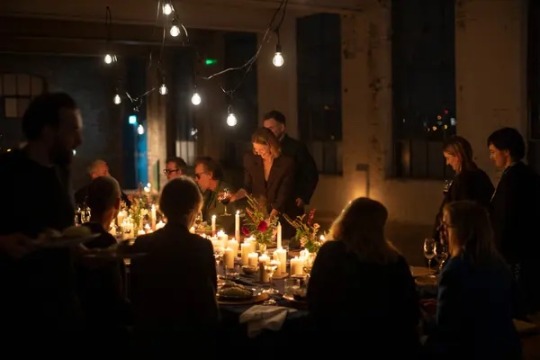
The actress Caitríona Balfe, center, taking her seat at the table. Photo: Rich Gilligan
T ENTERTAINING WITH
In Belfast, a Celebration of Art, Community and Pizza
In October, on the second floor of a former spinning mill in east Belfast, the visual artist and author Oliver Jeffers, 46, hosted a candlelit dinner for a group of Irish and Northern Irish artists and friends. The Portview Trade Centre, as the building is called, stopped producing textiles in the 1970s and is now home to 54 artists’ studios and creative businesses, including Jeffers’s, and his neighbors made up a large portion of the guests and the organizers. The occasion was a personal one — the launch of his 20th book, “Begin Again” — but he also wanted to celebrate his wider creative community. Accordingly, the evening combined tributes to both Belfast, where the artist has a home in the Holywood area, and Brooklyn, where he lived until recently and still has a studio.
VIDEO 📹 The author and illustrator Oliver Jeffers invited friends to toast his new book at a dinner in a former textile mill.
Jeffers is perhaps best known for his philosophical, understated children’s books, including “The Book Eating Boy” (2006) and “The Heart and the Bottle” (2010). And true to his style, “Begin Again” is curious, warm and quietly profound. “Not for kids, but not not for kids,” Jeffers says, the book is a vibrantly illustrated exploration of the climate crisis that attempts to lay out a hopeful future for humanity. “It offers an idea of slowing down, of using what’s near us — of starting over,” says Jeffers, “with the realization that we cannot do anything until we start to act with a sense of unity, to tell ourselves new stories that are defined by what we want.”

Jeffers, center (in tan jacket), sat beside the film director Lisa Barros Da’Sa, at left. Photo: Rich Gilligan (and Caitríona Balfe, at right… BIF)

Pearson Morris, the head chef of the Belfast restaurant Noble, pan-fried wild halibut in a makeshift kitchen set up not far from the table. Photo: Rich Gilligan
While guests gathered for drinks, the sun could be seen setting over the city; on the north side of the building, hills rolled down toward the sea. The food too — a collaboration between the local bistro Noble, known for its unpretentious ingredient-led dishes, and Flout, an American-style pizzeria on the ground floor of Portview — was unmistakably rooted in Belfast. Despite a limited power supply and a lack of running water in the room, dishes were assembled and cooked in situ using three portable pizza ovens and a small stove. The table was lit with clusters of white candles and, after the sun finally went down, said Jeffers, it glowed with “the warmth of a hearth at home.”
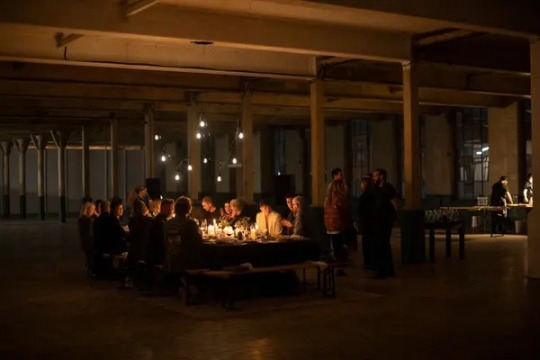
The dinner table stood at the center of the 10,000-square-foot room. Photo: Rich Gilligan
The attendees: Jeffers celebrated with his wife and business manager, Suzanne Jeffers, and a group of Irish and Northern Irish artists, including the actress Caitríona Balfe, 44; the portrait artist Colin Davidson, 55; the electronic musician and composer David Holmes, 54; the husband-and-wife film director duo Glenn Leyburn, 54, and Lisa Barros Da’Sa, 49; and the writers Glenn Patterson, 61, and Jan Carson, 43. “Everybody at this dinner,” said Jeffers, “was interested in the power of narrative, the impact of what they do and how it makes other people feel.”
The table: Guests sat at two long tables — pushed together to create a more intimate arrangement — in the middle of the otherwise nearly empty 10,000-square-foot room. The events stylist Rachel Worthington McQueen, 30, sourced an Irish linen tablecloth in the same navy hue as the book cover’s background. Mismatched dishes in traditional Blue Willow patterns (originally bought from secondhand websites for Worthington McQueen’s wedding two years ago) held squat candles, and food was served on simple white plates brought over from Noble. Seasonal blooms — including deep burgundy dahlias and pale pink spray roses — echoed the rich palette of the book and were provided by the local, sustainable flower farm Sow Grateful. Each display was tied with bright pink twine, sourced by Suzanne Jeffers to match the exact Pantone color (number 812U) of the book’s title.

New Haven-style mussels pizza by Peter Thompson, the founder of the pizzeria Flout, was served alongside Noble’s halibut. Photo: Rich Gilligan
The food: To start, Noble’s co-founder and head chef, Pearson Morris, 34, served crab and lobster from nearby Bangor Bay dressed with homemade mayonnaise and his Bloody Mary tomatoes (heritage tomatoes steeped overnight in a mix of vodka, celery and Tabasco sauce) on Flout’s blackened focaccia. “I bake things so you think they’re burned — that’s flavor for me,” said the pizzeria’s founder, Peter Thompson, 45. Next was a take on the classic New Haven-style clam pie made with steamed Galway Bay mussels, alongside which Morris served pan-fried wild halibut with a fish head sauce. Then came Flout’s Detroit-style pepperoni pizza and a salad featuring locally grown baby gem lettuces. Dessert was Noble’s chocolate delice — jaconde sponge cake topped with salted caramel, dark chocolate parfait and a chocolate mirror glaze — accompanied by a salted caramel ice cream with Flout’s sourdough chocolate cookies tumbled through.
The drinks: Noble’s front-of-house manager and co-founder, Saul McConnell, 38, oversaw the drinks, which ranged from a vibrant Blanc de Meunier champagne for arriving guests to an amber passito-style Liastos wine from Lyrarakis, Crete, for the dessert course. The Boundary Brewing Company, Belfast’s first tap room and one of Jeffers’s neighbors in the building, provided an alternative aperitif: a full-bodied English bitter called A Certain Romance, a favorite of Jeffers’s studio team.
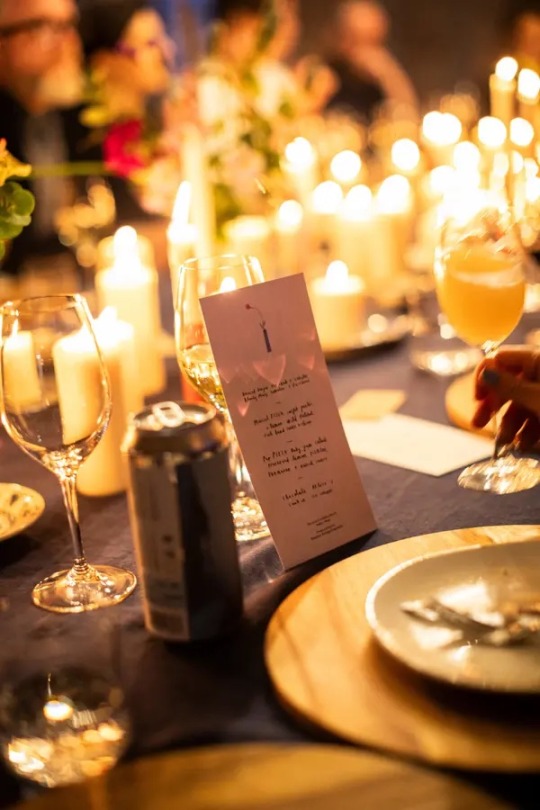
Jeffers illustrated the evening’s menus. Photo: Rich Gilligan

Noble’s chocolate delice, a jaconde sponge cake with salted caramel and a chocolate mirror glaze. Photo: Rich Gilligan
The conversation: Many artists talked shop, swapping notes on the production problems they encounter in their respective industries, and conversation also turned to global events. “There’s always been a comparison between the conflict in Northern Ireland and the conflict in Israel-Palestine,” said Jeffers. “We talked about the divisive rhetoric that’s going on right now.”
The music: Jeffers enlisted the Irish producer and D.J. Marion Hawkes, who runs the record store Sound Advice in Portview, to create a playlist, which ranged from classic folk to contemporary electronic tracks.
The recipe for Noble’s mayonnaise: It’s hard to beat fresh, homemade mayonnaise, says Morris, and it’s a quick, thoughtful addition to a dinner at home. But despite its few ingredients, it’s deceptively difficult to make. He recommends starting with equal parts white wine vinegar and egg yolk (approximately 2 teaspoons of vinegar to two yolks), which prevents the eggs from splitting as you very gradually beat in 250 ml of oil, then season with 5 grams of sugar and 5 grams of salt. Morris likes to use extra-virgin rapeseed oil for its neutral flavor, and an electric mixer for ease.
The New York Times Style Magazine
Remember… there’s always been a comparison between the conflict in Northern Ireland and the conflict in Israel-Palestine. We talked about the divisive rhetoric that’s going on right now. — Oliver Jeffers
Anon: Thanks… didn’t see your message until 10 minutes after posting. 🙁
#Tait rhymes with hat#Good times#Oliver Jeffers#Begin Again#2023#The New York Times#Style Magazine#8 December 2023#Thanks castlemaine123#My screenrecording
39 notes
·
View notes
Text
Rewrite the Stars
Summary: Austin is feeling homesick while filming Elvis and gets one hell of a birthday surprise!
Rating: General Audiences
Words: 3.6K (I swear this was meant to be a quick drabble, and yet here I am finishing this at almost five in the morning...oops?)
Warnings: Lots of pining from our boi here
Author's Note: This was written for @foreverdolly. I hope this fills the pining!Austin feels you were hoping for! Perhaps if this gets enough likes (and if school and work permits me), I’ll write a part two! A couple of minor details- I headcanoned Austin here as more of a serial dater rather than anything involving Vanessa. It felt more suitable, given the pining angle I’m going for. Also, I wrote this like COVID never happened because that is a reality I’m sure we’d all love to live in right now. Enjoy!
Austin knew that filming Elvis would be hard. One doesn’t go into a project about a beloved figure of American pop culture thinking it will be a walk in the park. Hell, the months-long audition process made that abundantly clear. But the most challenging part wasn’t the months and months of vocal training, singing lessons, costume fitting, or reading every possible book and watching every video about Elvis Aaron Presley he could get his hands on.
It was being away from his friends and family.
It was just him alone in an apartment halfway across the globe from the place and people he called home. It didn’t matter how many FaceTime calls he made with his sister Ashley or his childhood best friend Y/N or how many care packages they sent filled with his favorite snacks. Eventually, the calls ended, and the snacks were eaten.
His birthday was around the corner, although he was surprised he even registered that it was close. He texted Y/N to see if maybe you would be able to fly down for a quick visit. He even offered to pay for your plane ticket and introduce her to Baz, one of your favorite directors. That morning while he was in hair and makeup, you texted back, “Get me a spot on the soundtrack, and you got a deal!”
He snorted at the reference to the joke you made when he told you that he got the part…after screaming and crying out of excitement and happiness for him. You were the first person he wanted to tell when he got the news. You had been the one that encouraged him to go for the part in the first place. It had become a tradition between the two of you. Celebrating each other’s big moments. He remembered the day you told him about your record deal. He always believed you had the talent to follow your dreams. Growing up, you always wrote poetry and bits of songs, and the two of you constantly played guitar and piano in your room. It was one of the few spaces he felt comfortable enough to be himself. You never got frustrated with his shyness or anxiety, even agreeing to play in the dark to make him feel more comfortable. When you won your first Grammy, he was in the crowd, clapping until his hands ached.
Your subsequent text made his heart sink. “In all seriousness, I wish I could be there for your b-day. (Don’t think I forgot!) But I’m in the middle of recording my next album and my producer is a workhorse. I’m so sorry, Aus.”
“It’s okay,” he texted back. “It’s just 29. Should be done with filming before I turn 30 and we can do that one big!”
You sent back thumbs-up and blue heart emojis, and he tucked his phone into his pocket. There was a small lump in his throat. He closed his eyes for a moment. The last thing he wanted to do was cry over something so dumb. Because it was dumb! People didn’t stop living their lives back home just because he was in Australia. Jobs had to be done, bills had to be paid, and his feeling homesick like a little kid didn’t change that. His sister had sent back a similar response when he asked if she could come for a visit. He told her he understood and to not worry about him.
“Are you all right, Austin?”
He opened his eyes to his makeup artist Trisha looking at him in the mirror. She had a gift for reading his moods. Sometimes, he wished she wasn’t so accurate. He shrugged and mumbled, “Just got a disappointing text from home.”
“Sorry to hear that,” she said. She stayed silent for a moment, brushing more bronzer onto his face. “Want to talk about it?”
The lump in his throat hurt to talk around. “Not really.”
~~~~~~~~~~~~~~~~~~~~~~~~~~~~~~~~~~~~~~~~~~~~~~~~~~~~~~~~~~~~~~~
The day before his birthday, Baz picked Austin up at his apartment. He had a coffee waiting and was listening to the usual Elvis Presley playlist. He had long stopped being surprised by the Australian director’s eccentric nature. What surprised him was Baz didn’t drive them directly to set. Austin looked at the older man and asked, “Where we goin’?”
Baz just shrugged as he flipped on the turn signal. “The airport.”
This confused Austin. He tried to mask this by joking, “Is this your way of telling me I’m fired?”
That prompted a laugh out of Baz. “Nothing of the sort. I’m just picking up a friend. Flying them in for a special cameo for the film. I thought you’d like to tag along.”
“I’m not needed on set?”
“That is the beauty of being the director,” Baz replied with a grin. “I determine where you’re needed.”
Austin picked up the coffee Baz bought him and took a sip. “That’s not ominous at all, Mr. Luhrman.”
The two of you spent the rest of the drive discussing work. What Baz had planned, any concerns Austin may have, and what could be done to fix them. He loved working with Baz. He was unlike any director Austin had worked with previously. The man had a vision but never let that stop him from treating his cast and crew respectfully. Austin’s time in Hollywood had shown him what a rare quality that was in a director.
Before they knew it, they had arrived at the Brisbane airport. Baz had been tight-lipped about who exactly they were coming to get. He was happy he took care of getting dressed this morning. The weather flipped down in the Southern Hemisphere, so he woke up to a cold snap that morning. He put on a navy cashmere sweater Ashley bought him before he left. The closer his birthday got, the more intense his homesickness felt.
Baz parked the car, and the two of them headed inside. They were stopped a couple of times by fans eager for a selfie or an autograph. Austin watched as a young woman told Baz how she was inspired by his work to go to film school. He gave her some words of wisdom and agreed to take a photo with her. It was touching to witness and a lesson on how to talk with fans. Finally, they arrived at the area where people waited for arrivals. Austin turned and asked, “Gonna let me in on who we’re meeting?”
Baz looked up from his phone and simply gestured in the distance. Austin turned to where Baz was pointing and thought his heart would stop. It was Ashley and Y/N! They were here in Australia! Austin turned back to Baz, who simply said, “Happy birthday, son.”
Austin wasted no time sprinting toward the two women. He pulled his big sister in for a hug first, squeezing her tight and saying through tears, “If this is a dream, I hope I never wake up.”
He felt Ashley rub his back. “This is very real, little brother. And you have Baz and Y/N to thank for all this.”
He pulled away from his sister to see you standing there. Your eyes were glassy with tears even as you joked, “Well if you weren’t going to get me on the soundtrack, I figured I had to do it myself.”
Austin choked out a laugh and picked you up, spinning you around and squeezing you tight. His nickname for you growing up was Tink because of your tiny frame and fiery temper. When he finally set you down, he looked down at you as you explained, “Me and Ashley have been worried about you lately. You seemed really blue. So, I did the L.A. thing: I had my people reach out to Baz’s people and ask if we couldn’t arrange a surprise for your birthday.”
By this point, Baz had joined all three of you. He clapped Austin on the back and said, “I know that the Method is all the rage in Hollywood, but I don’t see sense in tormenting yourself needlessly. We can put production on pause for a little bit. Spend some time with these beautiful women who love you very much.”
~~~~~~~~~~~~~~~~~~~~~~~~~~~~~~~~~~~~~~~~~~~~~~~~~~~~~~~~~~~~~~~
That night, the three of you decided to stay at Ausitn’s place and order takeout later that evening. You were slightly more experienced with jetlag, but Ashley required a late afternoon nap. That gave the two of you time to catch up. Austin asked how work on your new album was going and just let your voice live and in person wash over him. You wore one of his t-shirts and a pair of sweatpants. Your hair was in a messy bun on top of your head, and your face was covered with one of those Korean skincare masks you loved. But to Austin, plain or dressed for a red carpet, you were the most beautiful woman he had ever seen.
He had always been a little in love with you. The timing never seemed to be on his side enough to make a move. As a teen, he was intimidated by your sudden rise to fame through MySpace. One day, you were posting songs you wrote, then suddenly, you had a record deal and were playing across the country. The last thing you needed was some awkward guy next to you whose biggest claim to fame was bit parts on iCarly and Hannah Montana.
As you both got older and started dating people, Austin figured maybe the two of you were meant to be just friends. He remembered watching a movie with that phrase as the title and the rant you went on after the movie ended.
“I swear to God,” you raged, “guys feel like just because they have feelings for a woman and treat her like a human being, that makes them entitled to sex with us! It’s disgusting! ‘Nice guys finish last’ is such misogynistic bullshit.”
You looked at him after finishing and squeezed his arm. “I’m so glad you’re not like that, Austin. You are rare among your gender.”
He never wanted to be that for you, either. He loved you as a person before he fell in love with you. The last thing he wanted was to be another creep trying to get into your pants. You had a long-term boyfriend, Trevor, who Austin could not stand. He was also a musician, and you met while on tour for your second album. It seemed like a match made in heaven. But Trevor had a nasty habit of comparing your careers, with his being more “legitimate” because he didn’t have to use the internet to become successful. It was a point he learned not to bring up around you or Austin unless he was ready for an argument to ensue.
“You know you’re going to have to introduce me to Tom Hanks,” you said, your eyes bright with excitement. “You know Forrest Gump is one of my favorite movies of all time. God knows how often I’ve watched Toy Story, Sleepless in Seattle, or You’ve Got Mail. I practically grew up with Tom Hanks!”
Austin grinned. “Ah, and so the true motivation for this trip emerges.”
“Oh, you were just a great bonus,” you teased as you removed your mask and massaged the excess product into your skin. “I’m here to see Woody.”
Austin laughed. Your presence melted away all of the angst he had been feeling lately. His whole body felt relaxed and at ease for the first time in months. At this moment, he didn’t have to worry about being ready for the set or rehearsing the same sequence for hours on end. He could just be Austin.
He reached out to squeeze your hand. You smiled and squeezed his back. His voice cracked as he whispered, “I’m so happy you’re here.”
“There’s nowhere else I’d rather be,” you replied.
You reached out to pull his head down and kissed his forehead. He couldn’t stop himself from encircling your wrist with his hand as you did. You pulled away slightly, and for a moment, you both breathed the same air. Your eyes connected. It could be so easy. He could just lean forward and do what he had been dreaming about for ages. He rubbed your inner wrist and found a racing pulse. You were so close. But…he wouldn’t do that to you. Austin knew how you felt about cheating, no matter how innocent the act was.
He was the first to break the moment. Clearing his throat, he pulled away and said, trying to force a laugh, “Don’t let Trevor hear you say that. How’s he doing, by the way? Still on tour?”
Something fell over your eyes at that moment. Before he could question it, you laughed harshly and said, “Yup, still touring. I think he’s still pissed because I told him I didn’t want his help on my next album. He’s been weird since I helped improve one of his singles by making it a duet. So now he’s needlessly looking for “improvements” in my work.”
Leave his sorry ass, Austin wanted to snap. You’re twice the songwriter he will ever be, and you deserve someone who recognizes true talent. The words were on the tip of his tongue. Instead, he said, “I’m sorry. Maybe it’s just a rough patch?”
“Yeah, maybe,” you replied. “But…they seem to be coming more frequently here lately.”
Scrubbing your face, you jumped up and said, “Bleh, enough about Trevor. Let’s see if Ashley has recovered enough so we can order something to eat. I’m starving!”
~~~~~~~~~~~~~~~~~~~~~~~~~~~~~~~~~~~~~~~~~~~~~~~~~~~~~~~~~~~~~~~
People could never say that Baz Luhrmann was a subtle man. For Austin’s birthday the following evening, he rented a restaurant with an adjoining karaoke bar. This surprise party had been well-planned. Catherine even decorated the space and ensured the manager secured any recording devices from non-guests. When the trio arrived, Austin hugged Baz and Catherine and thanked them for such kindness and generosity. Ashley wore a dusty rose off-the-shoulder dress with an A-line skirt that looked gorgeous. You looked stunning in a black cocktail dress inspired by Breakfast at Tiffany’s, complete with an updo and tiara. When you finally emerged from Austin’s bedroom, he mumbled, “Hello, gorgeous.”
You winked and said, “Thanks, but wrong movie.”
There was the usual dinner and giving of gifts. Baz, Tom, and others gave speeches, praising Austin so much that by the end, he was a puddle of tears and emotion. At the end of the dinner, he couldn’t say more than, “Thank you for all over this. Making this movie and being here with all of you has been one of the best experiences of my life. I will carry it with me and treasure it always.”
Once the dinner concluded, the party moved to the karaoke bar. Baz and you, as Austin figured, got along like a house on fire. Both of you were music nerds and kept trying to outdo each other in karaoke performances. You won the night with a spirited rendition of Tina Turner’s Proud Mary that saw your heels kicked into the crowd, your updo wholly wrecked, and Olivia holding your tiara as she screamed and cheered. As you exited the stage, Baz stood and bowed, saying, “I know when I’m beaten. Now, what’s this about you wanting to be on the soundtrack?”
A few others took turns on the stage. Dacre, Luke, and Adam tried to sing together to Billy Joel’s Uptown Girl. Tom and Rita sang I Got You, Babe before bidding everyone good night. Olivia, Ashley, Catherine, and you giggled through Wannabe by the Spice Girls. After the song ended, Olivia, Ashley, and Catherine teetered their way back off stage, but you remained. Putting a hand on your hip, you said into the microphone, “Mr. Butler…you are the only one who has not sung this evening. It’s time we fixed that. Get your ass up here!”
Everyone began chanting Austin’s name until he shrugged off his jacket and tie and joined you on stage. You had a look on your face that seemed both nervous and excited. Ever the performer, you turned back to the crowd and said, “Now, D.J., before you start the song we spoke about earlier, I wanna tell everyone here a little story about Austin and me.”
“Oh Jesus,” Austin said loud enough that the mic picked him up.
“Hush you,” you smacked his shoulder. “Anywho, me and Austin have a favorite pastime back home of watching bad movies together. It’s kind of like Mystery Science Theater 3000, snarking comments and all. Well, one of our favorites to watch is The Greatest Showman.”
This prompted boos and shouts from the crowd, to which you replied, “I know, I know. The movie made over a billion, and Hugh Jackman is your national treasure.”
You paused to allow people to cheer for their man before continuing, “But as an American…the movie is ridiculous. P.T. Barnum was a dick who did not deserve the talents of Mr. Hugh Jackman! But that soundtrack fucking rules! There would be nights when Austin and I couldn’t sleep, and we would drive around L.A. screaming that soundtrack at the tops of our lungs!”
You finally turned back to Austin, and he felt butterflies in his stomach. You smiled at him as your voice softened. “So we’re going to sing you of those songs tonight. Apologies in advance to Zendaya and Zac. May you never see this.”
Oh, Jesus…it was that song. You motioned for him to come closer. The butterflies were now a hurricane. He was about to sing a love song in front of a crowd of people to the woman he wanted more than anything. What could possibly go wrong?
“You know I want you,” Austin began, his voice shaky with nerves. “It’s not a secret I try to hide. I know you want me. So don’t keep saying our hands tied.”
A few people cheered, sensing his nerves. He grinned, and as the verse progressed, he felt his confidence growing. The two of you had watched this movie so many times, you began doing a facsimile of the scene from the film on stage. You kept your eyes downcast, your body turned away from him, as if you were fighting against this as much as you wanted to give in. At last, you came together at the end of the chorus, Austin going so far as to put his hand around your waist and tuck your hair behind your ear as he sang, “So why don’t we rewrite the stars? Maybe the world could be ours tonight?”
You took the microphone from the stand and took a giant step back as the music continued. Austin could hear his heart pounding in his ears. The look in your eyes reminded him of the look from yesterday. You lifted the microphone and sang, “You think it’s easy? You think I don’t want to run to you? But there are mountains and there are doors that we can’t walk through.”
You began walking along the edge of the stage and gesturing to the crowd as you continued to sing. Austin followed you as he felt the desperation behind the song's words for the first time. As you sang the chorus to the audience, he led you back to the center of the stage. And what’s more, you let yourself be guided back. You placed the microphone as the chorus ended, and you both began belting the bridge.
“All I want is to fly with you! All I want is to fall with you! So just give me all of you…”
There seemed to be something in your voice as you sang of this being impossible. Was he making this up? Was it just the two of you committing to the bit, as it were? The edges started to blur for Austin. Were they blurring for you too?
“You know I want you,” you sang finally, your voice just as shaky as he was at the song's beginning. “It’s not a secret I try to hide. But I can’t have you. We’re bound to fate, and my hands are tied.”
Both of you were startled when everyone began cheering. In those brief moments, they seemed to fade into the background. Before Austin even had time to process what the hell happened, you said into the microphone, “And that’s enough from me. Austin, thank you for humoring me. Maybe we can get him to sing an Elvis song next?”
He was shell-shocked as you hurried off stage to rejoin Ashley and Olivia. He wanted to follow you. He wanted to take you somewhere quiet and private and ask a million questions. What did you mean by that song choice? Were you trying to tell him something? But before he could even think of what to do first, he heard the all-too-familiar chords of Jailhouse Rock blast from the speakers.
~~~~~~~~~~~~~~~~~~~~~~~~~~~~~~~~~~~~~~~~~~~~~~~~~~~~~~~~~~~~~~~
A few days after you and Ashley returned to L.A., he got an email from his big sister. She had recorded your performance of Rewrite the Stars that night. The only text in the email stated, “If this is anything to go off of, I think you can, baby brother. Don’t waste this moment.”
Author’s Note: So…do we need a part two? Let me know down below! Likes, comments, and reblogs are cherished and adored.
120 notes
·
View notes
Text
Animation Night 72: Yamasong/Sam Koji Hale
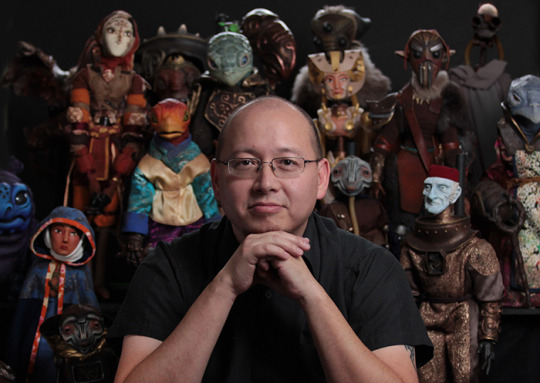
The Blue Blazes detour is over. We're back to our home ground: weird obscure animated films.
Recently I found out about a site called Kanopy, which lets you use a local library card to access a pretty neat library of films. I don't know if it's per-library or universal, but in any case, the Kanopy I have access to is mostly old films and documentaries - but it does have a pretty fascinating animation section including a bunch of films that are completely new to me.
One of these films is Yamasong: March of the Hollows.
This is a puppet film from 2016. The premise as I understand it is a fantasy world full of turtle people and robots, that's currently destablised by a conflict between the mechanical Hollows and beasts called the Tricksters, threatening all the other strange species that inhabit the planet. It falls to a cyborg called Nani and a turtle called Shojun to try and resolve the conflict. I don't know how this film never crossed my radar because the designs are fantastic - of course a puppet film brings to mind Dark Crystal, but equally it's got that Moebius sorta flavour, have a taste...
youtube
In an interview, director Sam Koji Hale describes how he took inspiration from Tezuka's Pheonix and ukiyo-e artist Tsukioka Yoshitoshi alongside the usual suspects like Kon and Miyazaki, trying to bring together images from multiple cultures - omnipresent kami and Matryoshka dolls.
The concept began as a short film that appeared at a handful of film festivals, inspired by the music of Shoji Kameda and his On Ensemble. Although this was successful at festivals, not a lot of studios were keen to back a feature-length puppet movie. The break came when one Sultan Saeed Al Darmarki, the owner of puppet studio Dark Dunes Production from the UAE, met up with Hale and offered to back the film as its producer.
Although certain sources like Wikipedia call it stop motion, I believe that may be incorrect - I think this is genuinely a puppet film, with puppeteers manipulating the figures in real time, draped in green to allow digital compositing...

And besides Hale, the film brings together a bunch of other notable American puppeteers, notably Heather Henson (daughter of Jim Henson) and Toby Froud (behind the recent Dark Crystal reboot, whose parents worked on the original). Puppet animation is something I'd like to cover more on here, especially Strings (2004) which still sits in my memory from many many years ago.
More recently, Hale worked on a Chinese film called 12 Zodiac, in which a group of animals must unite to remind the Jade Emperor that they exist. It sounds fascinating, but unfortunately I have not been able to find any more information than that IMDB page. If anyone knows a way to see this movie, let me know!!
So, if that sounds interesting, I hope you'll join me in checking this one out. I'm really curious to see what I missed! Animation Night will be going live momentarily, and the film will begin in about 20 minutes (22:40 UK time) at our usual twitch.tv/canmom - hope to see you there!
37 notes
·
View notes
Text
'The cast of "Oppenheimer" made good on their promise that they would walk out of the film's premiere in London if SAG-AFTRA (Screen Actors Guild-American Federation of Television and Radio Artists) officially called to strike following the AMPTP (Alliance of Motion Picture and Television Producers)'s failure to offer an equitable deal. While on the red carpet, "Oppenheimer" star Emily Blunt told Deadline, "I think right now we are just sorting of ... I hope everyone makes a fair deal and we are here to celebrate this movie." She continued, "And if they call it, we'll be leaving together as cast in unity with everyone ... We are gonna have to. We are gonna have to. We will see what happens. Right now it's the joy to be together."
Matt Damon echoed Blunt's sentiments. His company has already shut down the production of one film in solidarity with the ongoing Writers Guild of America (WGA) strike but recognized that this strike is not about celebrities consistently pulling in huge paychecks. "If our leadership is saying that the deal isn't fair, then we gotta hold strong until we get a deal that's fair for working actors," he said. "It's the difference between having healthcare and not for a lot of actors, and we gotta do what's right by them."
Well, the cast proved not to be all talk, as Blunt, Damon, Florence Pugh, Cillian Murphy, and many others in attendance walked out of the "Oppenheimer" premiere. This is standard practice for a SAG-AFTRA strike, which does not permit actors to do any promotional work, including press junkets, film premieres, and fan events like conventions.
Now I am become strike, the destroyer of studio greed
The entertainment industry is now in the midst of a double strike, which hasn't happened in over 60 years. The Director's Guild of America elected to ratify their deal with the AMPTP in June, avoiding a strike but certainly making them look clownish as they no longer have scripts or performers to direct until both strikes come to an end. Hope that "truly historic deal" was worth it and that you're excited to call "action" to AI holograms speaking lines written by ChatGPT, y'all! To be clear, my barbs are pointed at the leadership who buckled into accepting a deal, not the DGA as a whole, many of whom are in solidarity with both the WGA and SAG-AFTRA.
"Oppenheimer" is just the first of many film premieres that will be impacted by the strike. Just before the screening of the film in London, director Christopher Nolan addressed the crowd by acknowledging the hard work of the actors and respecting their choice not to attend the rest of the premiere. "They're off to go and write their picket signs," Nolan explained to the audience, who all cheered in solidarity with the actors' decision to leave.
Shortly after their exit, SAG-AFTRA held a press conference to announce the strike, which goes into effect one minute past midnight. I hope the studios are ready. If they thought the WGA picketers were disruptive, they're in for a rude awakening when thousands of former theater kids are unleashed outside their gates.'
60 notes
·
View notes